
Section E New Testament
Chapter 52 - Church of the Holy Sepulcher
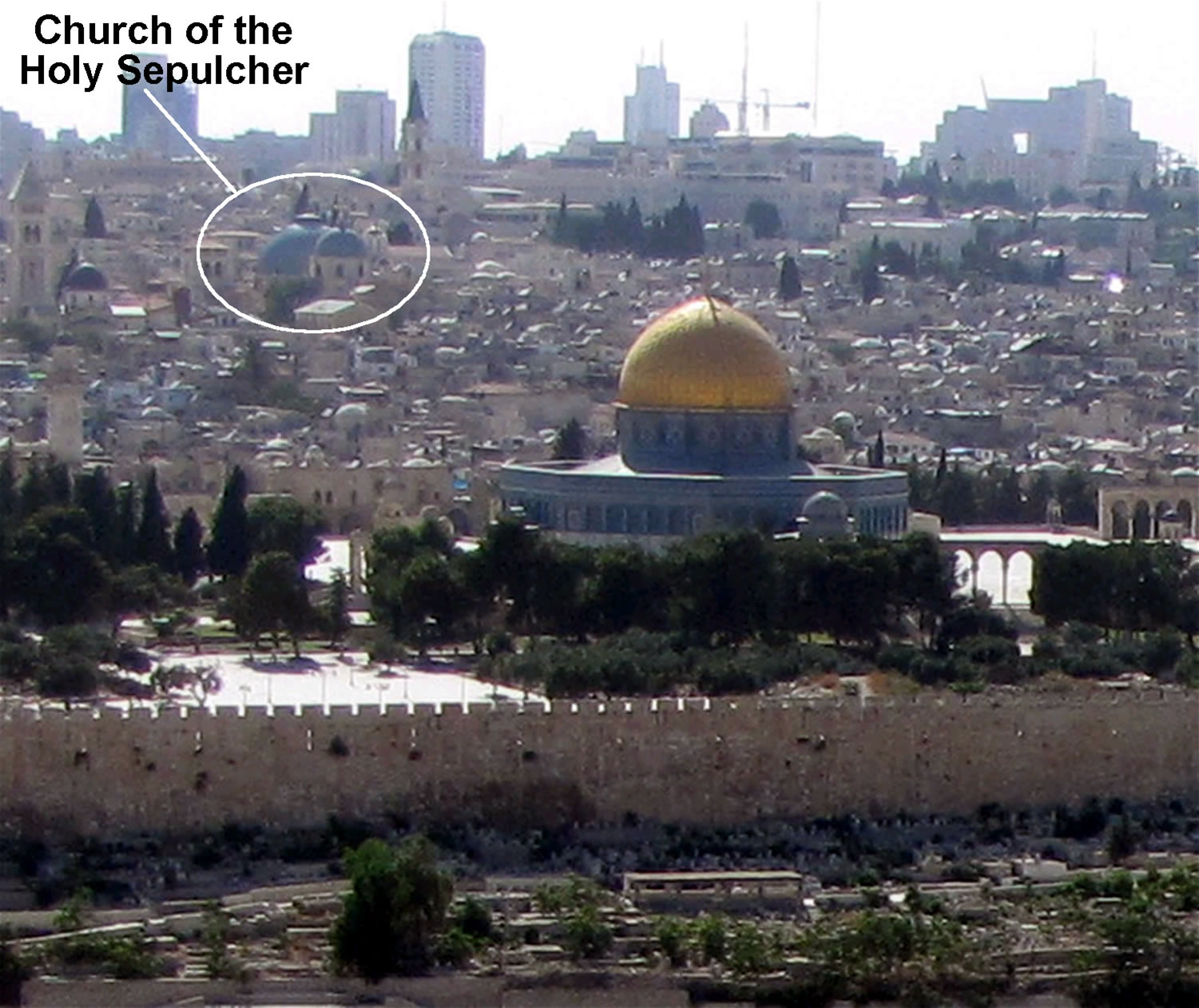
The two grey domes of the Church of the Holy Sepulcher can be seen in the skyline of this photo looking west from the Mount of Olives. The Dome of the rock, which sets in the middle of this photo on the Temple Mount, was built 300 years later to rival the proclamation of Constantine and the Christian world made by the then magnificent Church of the Holy Sepulcher. The church was later totally destroyed by the Muslims in 1009, only to be rebuilt by the Crusaders after 1100.
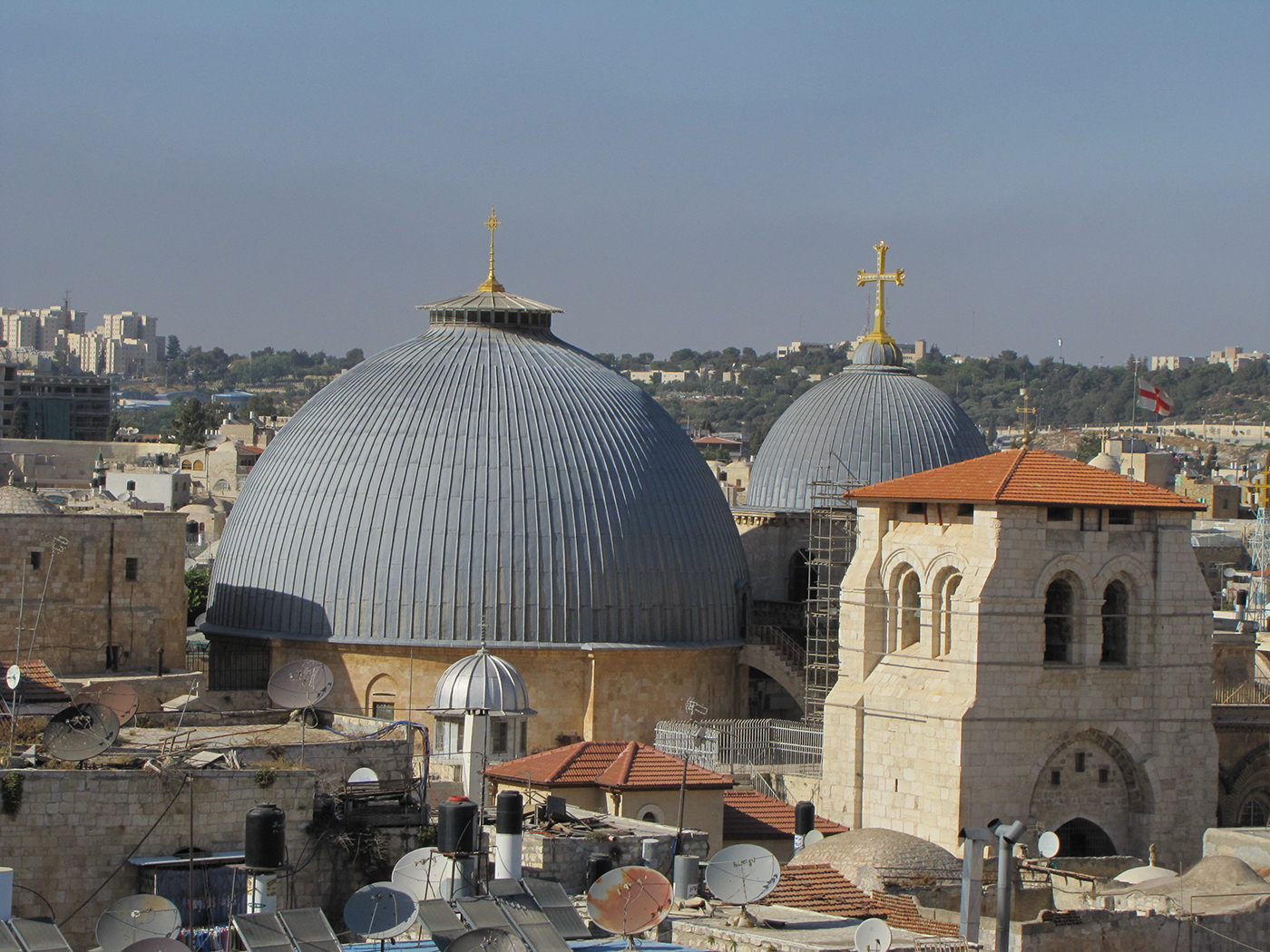
The Church of the Holy Sepulcher has been destroyed and rebuild several times through the centuries. The church we see today was constructed by the Crusaders. The small grey dome covers the rock of Calvary, and the large dome covers the site of Jesus’ burial and resurrection.
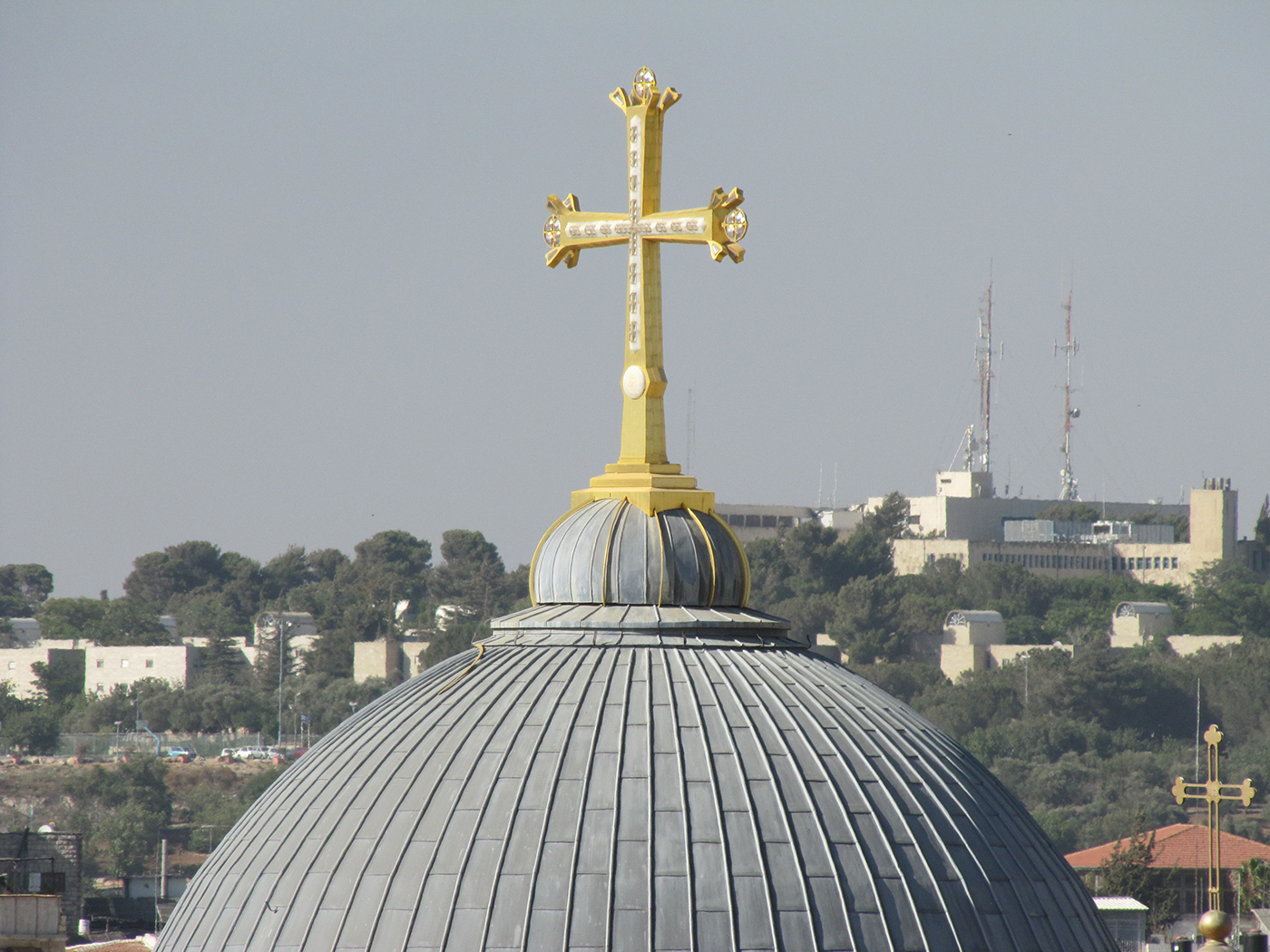
The cross on the grey dome over Calvary in the Church of the Holy Sepulcher.
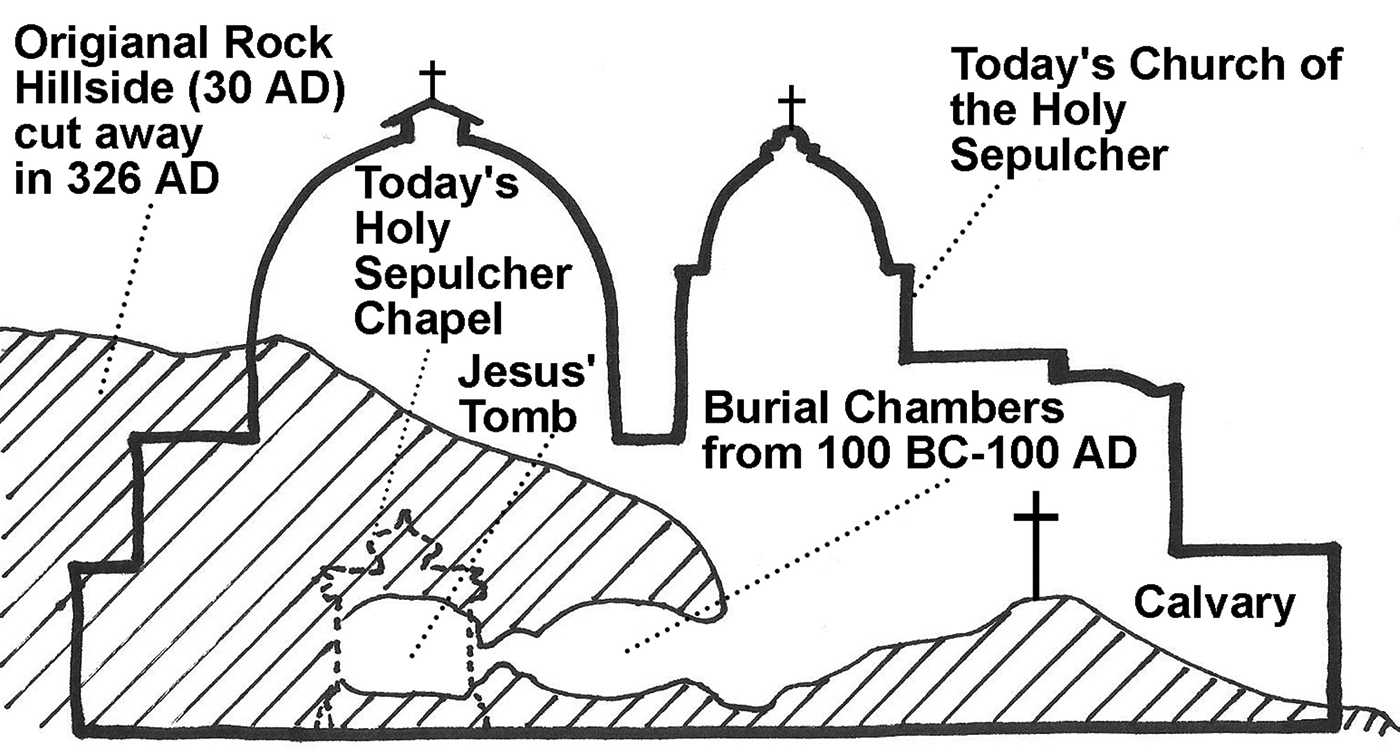
Today's Church of the Holy Sepulcher sets over two sites: Calvary and the tomb of Jesus. Both these sites were in the same garden outside the walls of Jerusalem in 30 AD, and now they are under one roof. John wrote that they were close to each other:
The area where the Church sits today was a large limestone quarry in 600-700 BC. The city of Jerusalem was to the SE and expanded first to the west before it came north toward the quarry. In an area east of St. Helena’s Chapel in the Church of the Holy Sepulcher the quarry was over 40 feet deep.
At the place where Jesus was crucified, there was a garden, and in the garden a new tomb, in which no one had ever been laid. Because it was the Jewish day of Preparation and since the tomb was nearby, they laid Jesus there. - John 19:41-42
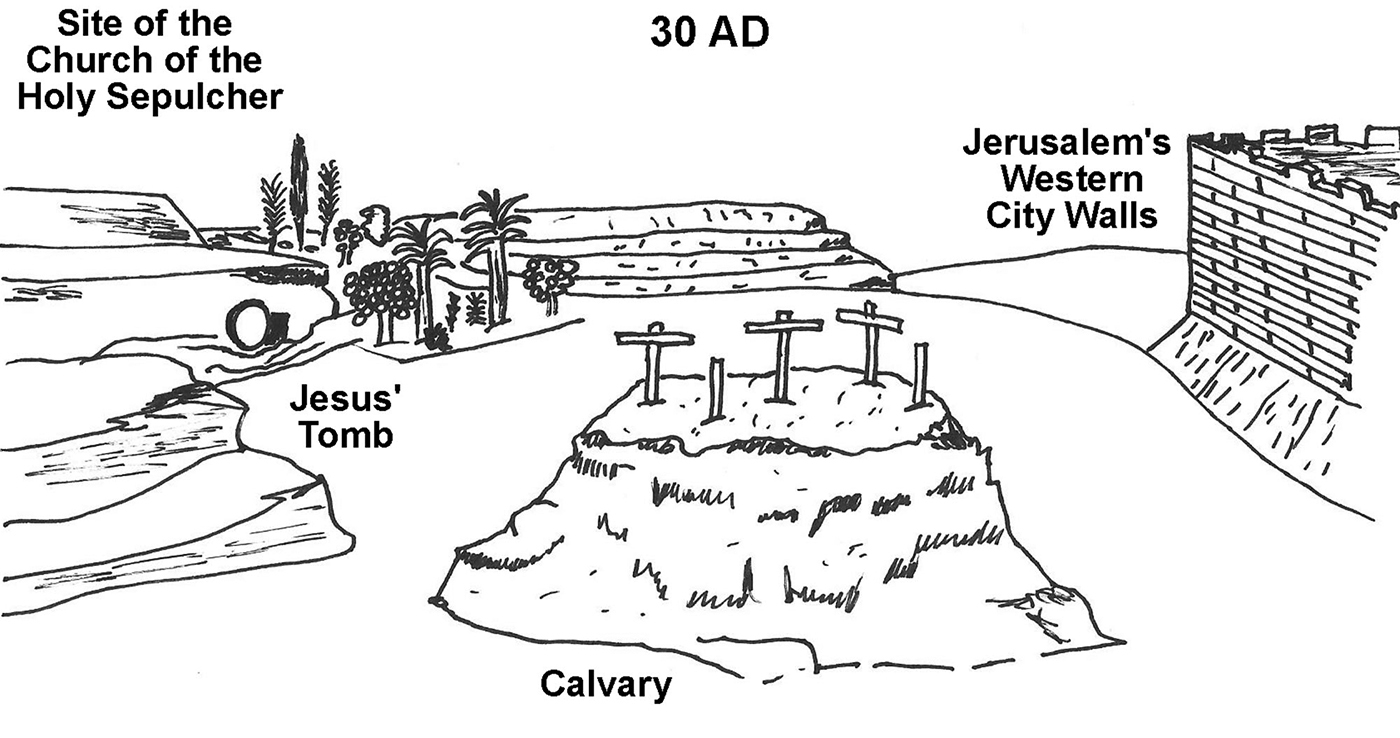
The drawing above shows the abandoned quarry that was covered with reddish-brown soil in the 100’s BC in order to create a garden. The area also supported cereal crops and an orchard of fig, carob, and olive trees.
In 30 AD, this was the perfect place to cut new graves because of the bedrock left exposed around the quarry, because it had only recently become available so still had lots of available space, and because it was close to the city yet still outside the walls. Jerusalem was, and still is, surrounded by graves that had used for a thousand years leading up to 30 AD. This new garden was indeed a great opportunity for Joseph to be able to cut a grave so close to the city:
Now there was a man named Joseph, a member of the Council, a good and upright man, who had not consented to their decision and action. He came from the Judean town of Arimathea and he was waiting for the kingdom of God. Going to Pilate, he asked for Jesus’ body. Then he took it down, wrapped it in linen cloth and placed it in a tomb cut in the rock, one in which no one had yet been laid. - Luke 23:50-53
Four tombs from this period have been excavated. One of the tombs was a kokh, a long, narrow recess carved for the placement of a body. Bones were left in the kokh for a period of time, then later collected and placed in an ossuary. Due to this method of dealing with dead bodies, tombs would rarely be “new” tombs, since they were used over and over by a family or a group of people. Another tomb found in this area was an arcosoliuim, or a shallow, rock-hewn coffin cut into the side of a wall with an arch-shaped top. This tomb has been chipped away by centuries of pilgrims. The third is a large tomb that, like the kokh mentioned above, was found in front of the church in the entry courtyard. Constantine cut this tomb larger to use as a cistern. Finally, another kokh tomb was found under the Coptic convent. It is clear and undeniable that the Church of the Holy Sepulcher stands on the site of a burial ground from the time of Jesus in the first-century. The Jews buried their dead outside the city walls. Jesus himself was crucified outside the city walls:
Not only that, but Jesus was also buried outside the city in a garden:And so Jesus also suffered outside the city gate to make the people holy through his own blood. Let us, then, go to him outside the camp, bearing the disgrace he bore. -Hebrews 13:12, 13
At the place where Jesus was crucified, there was a garden, and in the garden a new tomb, in which no one had ever been laid. -John 19:41
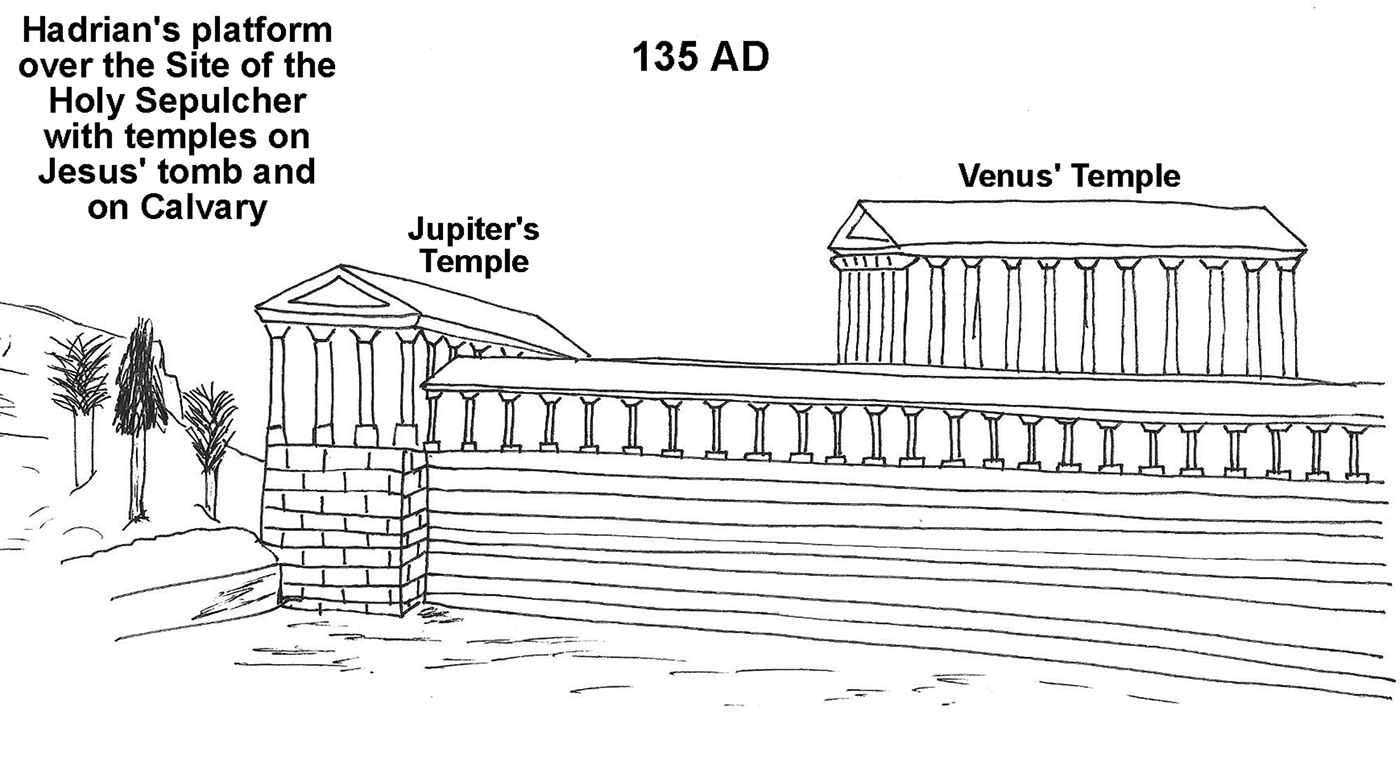
In 135, after the second Jewish revolt (132-135), Hadrian rebuilt Jerusalem as the Roman city, Aelia Capitolina. He also renamed Judea “Palaestina” (that is, Palestine), after the ancient enemies of the Jews, the Philistines, who had ceased to be a people after the Babylonian invasions around 586 BC. Hadrian built a huge raised platform (a rectangular retaining wall filled with dirt) on the location of this ancient quarry covered with gardens and tombs in an effort to bury Calvary and the tomb of Jesus, an honored site of the Christians. The platform was needed to level the stone surface that was cut up by the quarry and the tombs. Hadrian built the retaining wall of this platform with Herodian ashlars (most likely from the Jewish Temple Mount). These stones are identical in size and facing to the Herodian ashlars in the retaining wall of the Temple Mount, which made Hadrian’s wall look like Herod’s Western Wall. Hadrian then built a temple to Venus on top of this platform.
Eusebius writes about this pagan shrine in his work entitled, The Life of Constantine, written around 339 AD:
For it had been in time past the endeavor of impious men (or rather let me say of the whole race of evil spirits through their means), to consign to the darkness of oblivion that divine monument of immortality to which the radiant angel had descended from heaven, and rolled away the stone for those who still had stony hearts, and who supposed that the living One still lay among the dead; and had declared glad tidings to the women also, and removed their stony-hearted unbelief by the conviction that he whom they sought was alive. This sacred cave, then, certain impious and godless persons had thought to remove entirely from the eyes of men, supposing in their folly that thus they should be able effectually to obscure the truth. Accordingly they brought a quantity of earth from a distance with much labor, and covered the entire spot; then, having raised this to a moderate height, they paved it with stone, concealing the holy cave beneath this massive mound. Then, as though their purpose had been effectually accomplished, they prepared on this foundation a truly dreadful sepulchre of souls, by building a gloomy shrine of lifeless idols to the impure spirit whom they call Venus, and offering detestable oblations therein on profane and accursed altars. For they supposed that their object could not otherwise be fully attained, than by thus burying the sacred cave beneath these foul pollutions. Unhappy men! they were unable to comprehend how impossible it was that their attempt should remain unknown to him who had been crowned with victory over death, any more than the blazing sun, when he rises above the earth, and holds his wonted course through the midst of heaven, is unseen by the whole race of mankind. Indeed, his saving power, shining with still greater brightness, and illumining, not the bodies, but the souls of men, was already filling the world with the effulgence of its own light.
In 30 AD, this was the perfect place to cut new graves because of the bedrock left exposed around the quarry, because it had only recently become available so still had lots of available space, and because it was close to the city yet still outside the walls. Jerusalem was, and still is, surrounded by graves that had used for a thousand years leading up to 30 AD. This new garden was indeed a great opportunity for Joseph to be able to cut a grave so close to the city:
Now there was a man named Joseph, a member of the Council, a good and upright man, who had not consented to their decision and action. He came from the Judean town of Arimathea and he was waiting for the kingdom of God. Going to Pilate, he asked for Jesus’ body. Then he took it down, wrapped it in linen cloth and placed it in a tomb cut in the rock, one in which no one had yet been laid. - Luke 23:50-53
Four tombs from this period have been excavated. One of the tombs was a kokh, a long, narrow recess carved for the placement of a body. Bones were left in the kokh for a period of time, then later collected and placed in an ossuary. Due to this method of dealing with dead bodies, tombs would rarely be “new” tombs, since they were used over and over by a family or a group of people. Another tomb found in this area was an arcosoliuim, or a shallow, rock-hewn coffin cut into the side of a wall with an arch-shaped top. This tomb has been chipped away by centuries of pilgrims. The third is a large tomb that, like the kokh mentioned above, was found in front of the church in the entry courtyard. Constantine cut this tomb larger to use as a cistern. Finally, another kokh tomb was found under the Coptic convent. It is clear and undeniable that the Church of the Holy Sepulcher stands on the site of a burial ground from the time of Jesus in the first-century. The Jews buried their dead outside the city walls. Jesus himself was crucified outside the city walls:
Not only that, but Jesus was also buried outside the city in a garden:And so Jesus also suffered outside the city gate to make the people holy through his own blood. Let us, then, go to him outside the camp, bearing the disgrace he bore. -Hebrews 13:12, 13
At the place where Jesus was crucified, there was a garden, and in the garden a new tomb, in which no one had ever been laid. -John 19:41
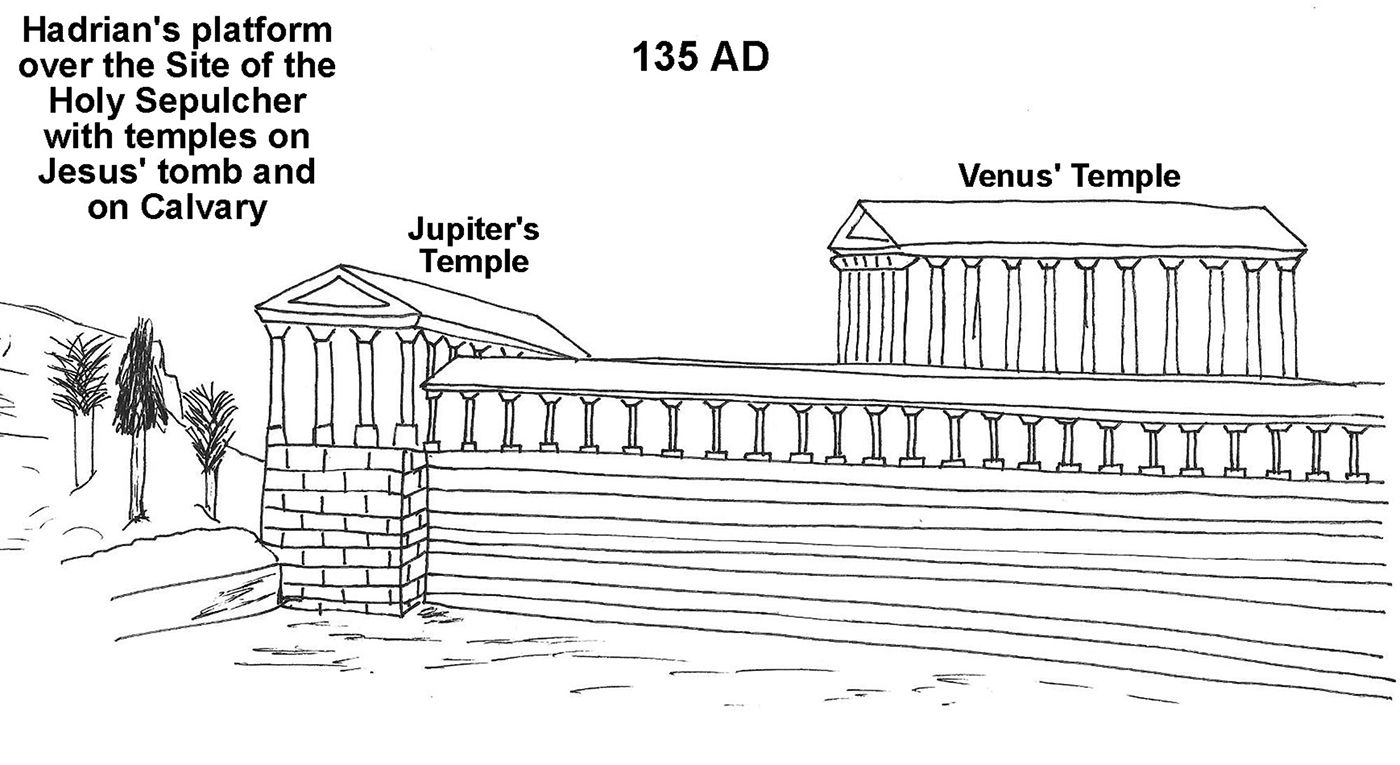
In 135, after the second Jewish revolt (132-135), Hadrian rebuilt Jerusalem as the Roman city, Aelia Capitolina. He also renamed Judea “Palaestina” (that is, Palestine), after the ancient enemies of the Jews, the Philistines, who had ceased to be a people after the Babylonian invasions around 586 BC. Hadrian built a huge raised platform (a rectangular retaining wall filled with dirt) on the location of this ancient quarry covered with gardens and tombs in an effort to bury Calvary and the tomb of Jesus, an honored site of the Christians. The platform was needed to level the stone surface that was cut up by the quarry and the tombs. Hadrian built the retaining wall of this platform with Herodian ashlars (most likely from the Jewish Temple Mount). These stones are identical in size and facing to the Herodian ashlars in the retaining wall of the Temple Mount, which made Hadrian’s wall look like Herod’s Western Wall. Hadrian then built a temple to Venus on top of this platform.
Eusebius writes about this pagan shrine in his work entitled, The Life of Constantine, written around 339 AD:
For it had been in time past the endeavor of impious men (or rather let me say of the whole race of evil spirits through their means), to consign to the darkness of oblivion that divine monument of immortality to which the radiant angel had descended from heaven, and rolled away the stone for those who still had stony hearts, and who supposed that the living One still lay among the dead; and had declared glad tidings to the women also, and removed their stony-hearted unbelief by the conviction that he whom they sought was alive. This sacred cave, then, certain impious and godless persons had thought to remove entirely from the eyes of men, supposing in their folly that thus they should be able effectually to obscure the truth. Accordingly they brought a quantity of earth from a distance with much labor, and covered the entire spot; then, having raised this to a moderate height, they paved it with stone, concealing the holy cave beneath this massive mound. Then, as though their purpose had been effectually accomplished, they prepared on this foundation a truly dreadful sepulchre of souls, by building a gloomy shrine of lifeless idols to the impure spirit whom they call Venus, and offering detestable oblations therein on profane and accursed altars. For they supposed that their object could not otherwise be fully attained, than by thus burying the sacred cave beneath these foul pollutions. Unhappy men! they were unable to comprehend how impossible it was that their attempt should remain unknown to him who had been crowned with victory over death, any more than the blazing sun, when he rises above the earth, and holds his wonted course through the midst of heaven, is unseen by the whole race of mankind. Indeed, his saving power, shining with still greater brightness, and illumining, not the bodies, but the souls of men, was already filling the world with the effulgence of its own light.
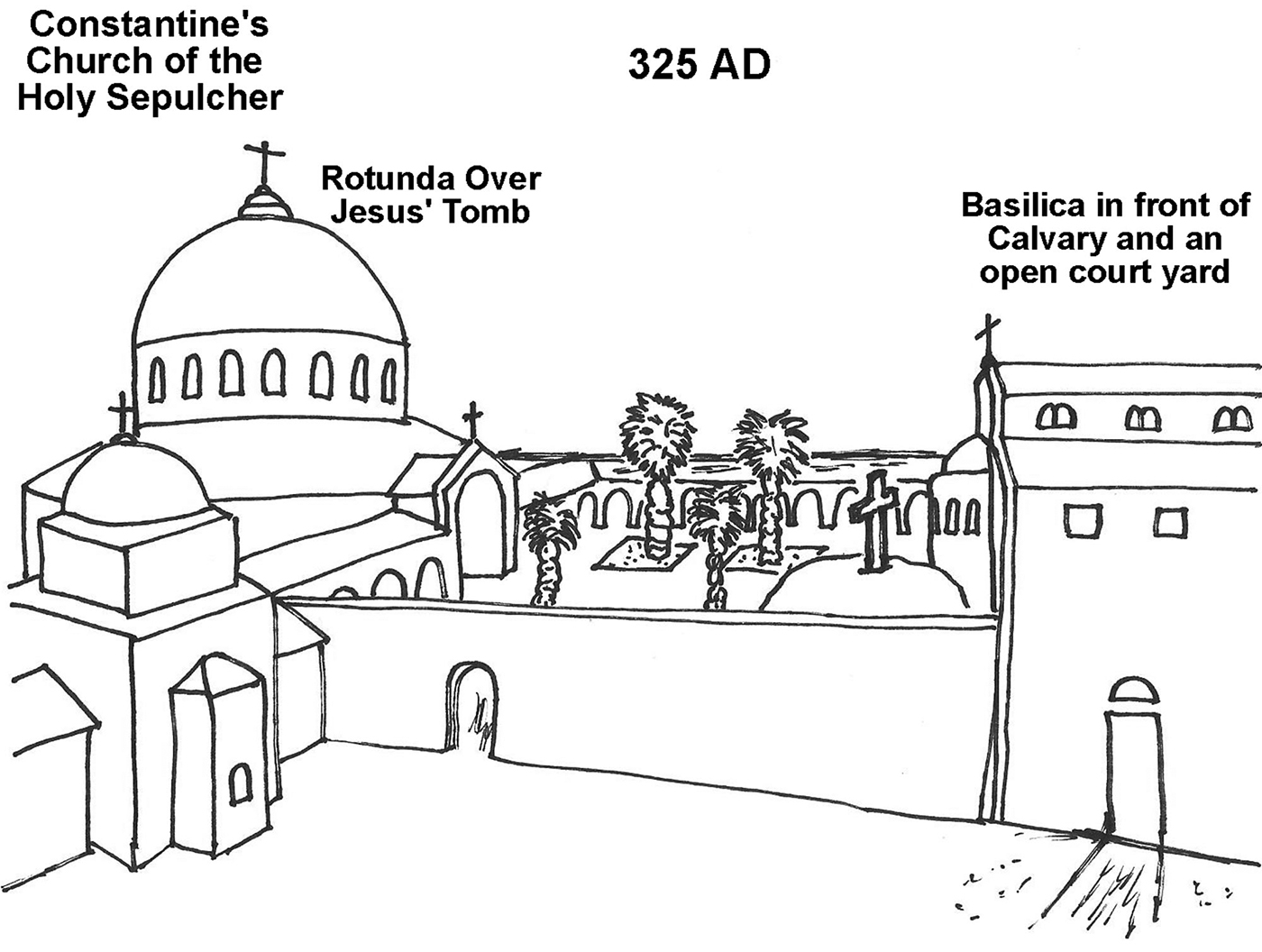
Construction of Constantine's Church of the Holy Sepulcher was begun in 326, and the building was dedicated on September 17, 335. The cutting away of all rock around the tomb was not completed until 384.
In 325 at the Council of Nicea, Macarius, the bishop of Jerusalem from 314 to 333, petitioned Constantine to demolish Hadrian’s temple and uncover the tomb of Christ. In 326 AD Helena, Constantine’s mother, visited Jerusalem and was told the site of Hadrian’s temple was the site of Jesus burial and resurrection. Constantine then ordered a rotunda to be built around Jesus’ tomb which sat in front of Calvary, and on the other side of Calvary, Constantine built a long basilica church.
Eusebius goes on to record how Constantine ordered the destruction of Hadrian’s pagan shrine and the removal of the material and soil used to cover up the tomb of Jesus:
He (Constantine) could not consent to see the sacred spot of which we have spoken, thus buried, through the devices of the adversaries, under every kind of impurity, and abandoned to forgetfulness and neglect; nor would he yield to the malice of those who had contracted this guilt, but calling on the divine aid, gave orders that the place should be thoroughly purified ... As soon, then, as his commands were issued, these engines of deceit were cast down from their proud eminence to the very ground, and the dwelling-places of error, with the statues and the evil spirits which they represented, were overthrown and utterly destroyed. . . Nor did the emperor’s zeal stop here; but he gave further orders that the materials of what was thus destroyed, both stone and timber, should be removed and thrown as far from the spot as possible; and this command also was speedily executed. The emperor, however, was not satisfied with having proceeded thus far: once more, fired with holy ardor, he directed that the ground itself should be dug up to a considerable depth, and the soil which had been polluted by the foul impurities of demon worship transported to a far distant place. (The Life of Constantine, book III, chapter XXVI and XXVII)
As mentioned earlier, the stones that Constantine removed from the destroyed pagan shrine may have been Herodian ashlars from the Temple Mount. Still today there are Herodian ashlar stones at the depths of the foundations of the Church of the Holy Sepulcher.
When all the stone, debris, and soil were removed from Hadrian’s shrine the original rock quarry and tomb of Christ became visible. Eusebius, the church historian and biographer of Constantine continues to write around 329 AD:
As soon as the original surface of the ground, beneath the covering of earth, appeared, immediately, and contrary to all expectation, the venerable and hallowed monument of our Savior’s resurrection was discovered. Then indeed did this most holy cave present a faithful similitude of his return to life, in that, after lying buried in darkness, it again emerged to light, and afforded to all who came to witness the sight, a clear and visible proof of the wonders of which that spot had once been the scene, a testimony to the resurrection of the Savior clearer than any voice could give. (The Life of Constantine, Book III, Chapter XXVIII)
Constantine then gave orders to the governors of the Eastern provinces to build a house of prayer. Eusebius records the order this way:
The emperor sent forth injunctions which breathed a truly pious spirit, at the same time granting ample supplies of money, and commanding that a house of prayer worthy of the worship of God should be erected near the Saviour’s tomb on a scale of rich and royal greatness. (The Life of Constantine, Book III, Chapter XXIX)
Eusebius even records the letter Constantine sent to Macarius, the presiding bishop over the church at Jerusalem at that time. In the letter Constantine describes his plans for the new construction and asks for Macarius’ advice concerning the ceiling of the church:
It will be well, therefore, for your sagacity to make such arrangements and provision of all things needful for the work, that not only the church itself as a whole may surpass all others whatsoever in beauty, but that the details of the building may be of such a kind that the fairest structures in any city of the empire may be excelled by this . . . and as to the columns and marbles, whatever you shall judge, after actual inspection of the plan, to be especially precious and serviceable, be diligent to send information to us in writing, in order that whatever quantity or sort of materials we shall esteem from your letter to be needful, may be procured from every quarter, as required, for it is fitting that the most marvelous place in the world should be worthily decorated. With respect to the ceiling of the church, I wish to know from you whether in your judgment it should be panel-ceiled, or finished with any other kind of workmanship. If the panel ceiling be adopted, it may also be ornamented with gold. (The Life of Constantine, Book III, Chapter XXX and XXX1)
It is interesting to note Eusebius’ understanding of the eschatological value of these events, and it is worth noting that Eusebius’ view reflected the attitude of Constantine and the general Christian of that day. Eusebius’ interpretation of scripture and his understanding of eschatological events led him and Constantine to consider this building project part of the New Jerusalem, and Constantine’s reign as the reappearance of Christ on earth to rule through his church. This was one of several corruptions of eschatological interpretation that was to happen throughout church history. Eusebius wrote:
Accordingly, on the very spot which witnessed the Savior’s sufferings, a new Jerusalem was constructed, over against the one so celebrated of old, which, since the foul stain of guilt brought on it by the murder of the Lord, had experienced the last extremity of desolation, the effect of Divine judgment on its impious people. It was opposite this city that the emperor now began to rear a monument to the Savior’s victory over death, with rich and lavish magnificence. And it may be that this was that second and new Jerusalem spoken of in the predictions of the prophets, concerning which such abundant testimony is given in the divinely inspired records. (The Life of Constantine, Book III, Chapter XXXIII)
Of course, the destruction of all Christian churches including the original Church of the Holy Sepulcher by the Persian hordes in 638, and the total destruction of the rebuilt Church of the Holy Sepulcher by the Muslim Egyptian Caliph al-Hakim in 1009, both provided clear evidence that the New Jerusalem had not yet come.
When the crusaders arrived in 1099 they rebuilt the ruined church with parts of Hadrian’s temple that can be seen in eight different locations in the church today. The crusaders also used the remains of Constantine’s glorious rotunda and basilica, including marble pillars they reduced to half their original size. Godfrey of Bouillon became the first Crusader king of Jerusalem on July 15, 1099 and called himself the “Defender of the Holy Sepulcher.” The Crusader church was completed fifty years later in 1149.
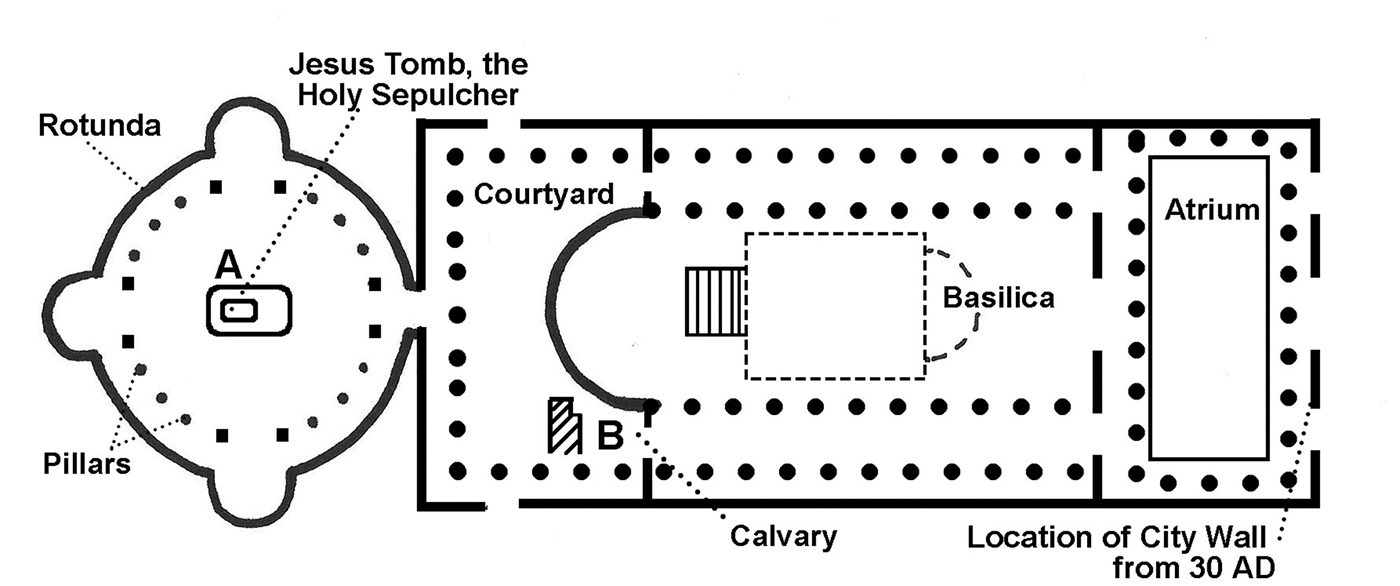
This is the floor plan of Constantine's magnificent and extravagant Church of the Holy Sepulcher. It consisted of a Basilica, a colonnaded courtyard around Calvary, and a large colonnaded rotunda around Jesus’ tomb.

This is how the abandoned quarry/garden with graves would have looked in 30 AD. Notice the location of the northwest wall of the city on the right.

After Roman Emperor Hadrian squelched the Second Jewish Revolt in 135 AD, he desecrated the Temple Mount with pagan temples and a statue of himself. He also built a platform with pagan shrines on top of Calvary and the tomb of the Christian’s God and Savior, Jesus. This made the Jewish Temple Mount and both of the Christian sites inaccessible to worshippers, yet at the same time, it preserved the knowledge of their location so that Constantine was able to build the Church of the Holy Sepulcher here.

This diagram shows the large amount of stone that was chipped away by Constantine's workers in order to prepare Calvary and the tomb for the Byzantine building project. Notice the tomb of Christ (A). The letter “A” is on the inside of the tomb where the burial slab that held Jesus’ body is located. The white box around the tomb is rock that was left intact. The rest of the rock was chipped away to form a square rock box around the tomb and burial bench of Jesus. Constantine then built a rotunda around this rock box with the tomb inside.
Recent excavations have revealed Herodian ashlars in the remains of Hadrian’s foundation walls at the lowest levels of the Church of the Holy Sepulcher. The presence of these stones helps confirm that this is the actual site of Jesus’ burial.
Further evidence comes from a time even before Constantine built his church in 326. When Constantine’s mother visited Jerusalem she was told that this exact spot was the location of Calvary and Christ’s tomb. The fact that by 326 this area was inside the busy city of Jerusalem is strong evidence that they were right.
Based on the testimony of scripture and our knowledge of ancient Jewish practice, it is certain that Jesus was buried outside the city walls. But this site was inside the city. Had they not actually known and been merely guessing, they would have picked a more logical place. For example, the Garden Tomb, also known as Gordon’s Calvary, would have been a much better guess. Even today it looks like a better location for Jesus’ death, burial and resurrection. The fact that Helena was shown this unlikely site in 326 gives it credibility. In addition to the location being inside the walls in 326, another fact lends credibility to the Christians’ assertion: Hadrian’s pagan shrine was still standing there when Helena visited. If they did not know for certain they were right, why would the Christians have believed the burial site of their resurrected Lord had been buried under a vile temple of corrupt pagan worship for 190 years?
Archaeology has now confirmed three important facts about the current site of the Church of the Holy Sepulcher:
1. It was outside the city walls of Jerusalem in 30 AD
2. It had many tombs in the first century (and they are clearly seen yet today)
3. There is an earlier building here that was built before the time of Constantine and Helena (i.e., Hadrian’s temple to Venus)
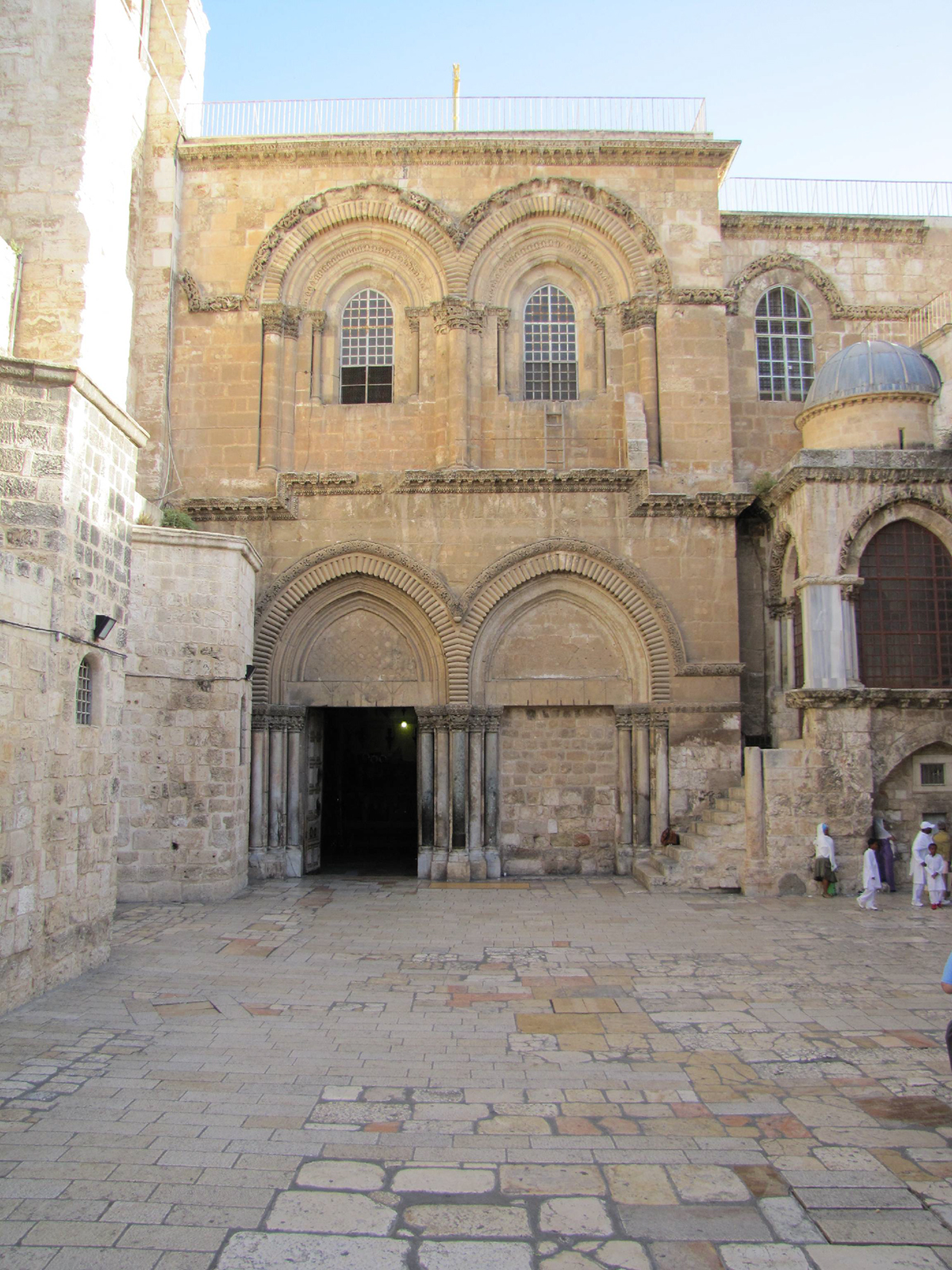
This is the entrance to the Church of the Holy Sepulcher. The current building was inaugurated by the Crusaders who rebuilt it in 1149. This site was honored by first century Christians, buried by Hadrian in 135, identified by local believers in 326, covered by Constantine’s church by 335, which was then destroyed by the Persians in 614, only to be rebuilt and destroyed again by the Muslim Caliph Hakim in 1009. The right (east) half of the main entrance to the church was walled shut by the Muslims after the Crusaders lost Jerusalem in 1187.
Today this church is shared by six groups of Christians:
Latin Catholics, Greek Orthodox, Armenian Orthodox, Syrians, Copts, and Ethiopians.
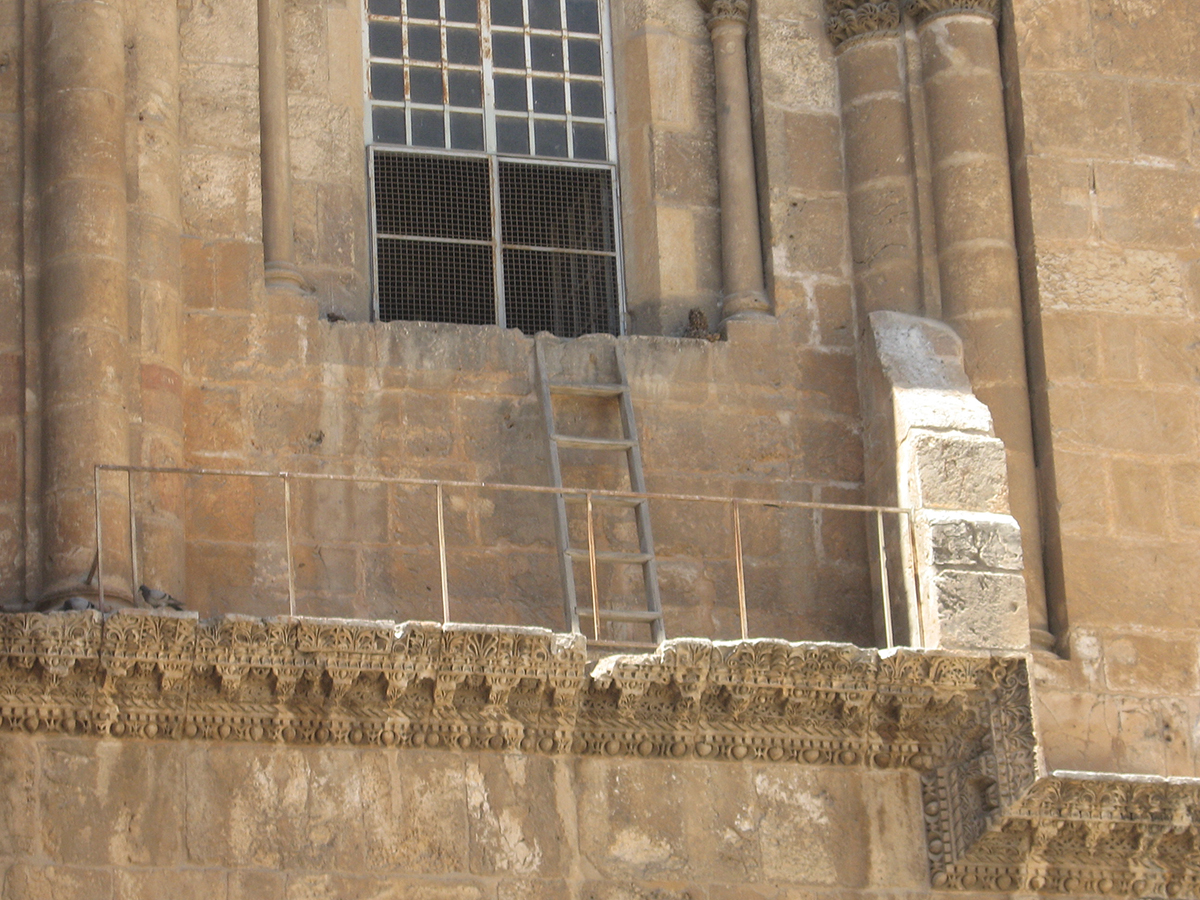
This ladder is located on a ledge above the main entrance. It was placed there some time in the late 1800’s to take food to Armenian monks who were locked inside the church. This ladder can be seen in photos from at least 1890. The ladder remains where it is because the various Christian groups that control the church cannot agree on who is responsible for putting it away. Each of the six groups - Greek Orthodox, Roman (Latin) Catholics, Armenians, Copts, Syrians, and Ethiopians – have their own areas of jurisdiction which were precisely defined in 1852.
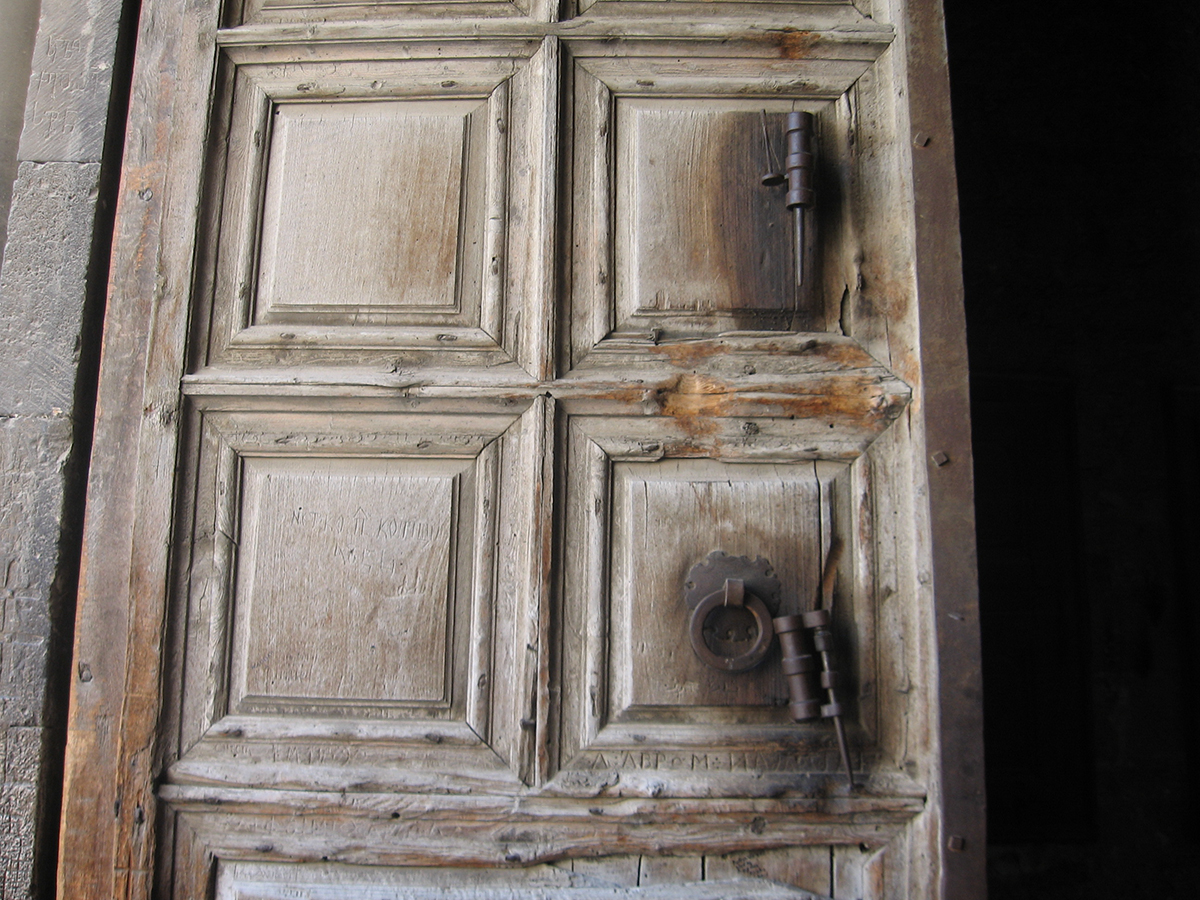
The front door on the left side of the entryway of the Church of the Holy Sepulcher shows charred remains near the metal handles and locks from a serious fire in the church in 1808. In 1927 an earthquake also caused great damage to the church. Damage from the earthquake was not repaired until 1959 because it took 32 years for the Latin, Greek and Armenian Christians to come to an agreement on how the church was to be repaired.
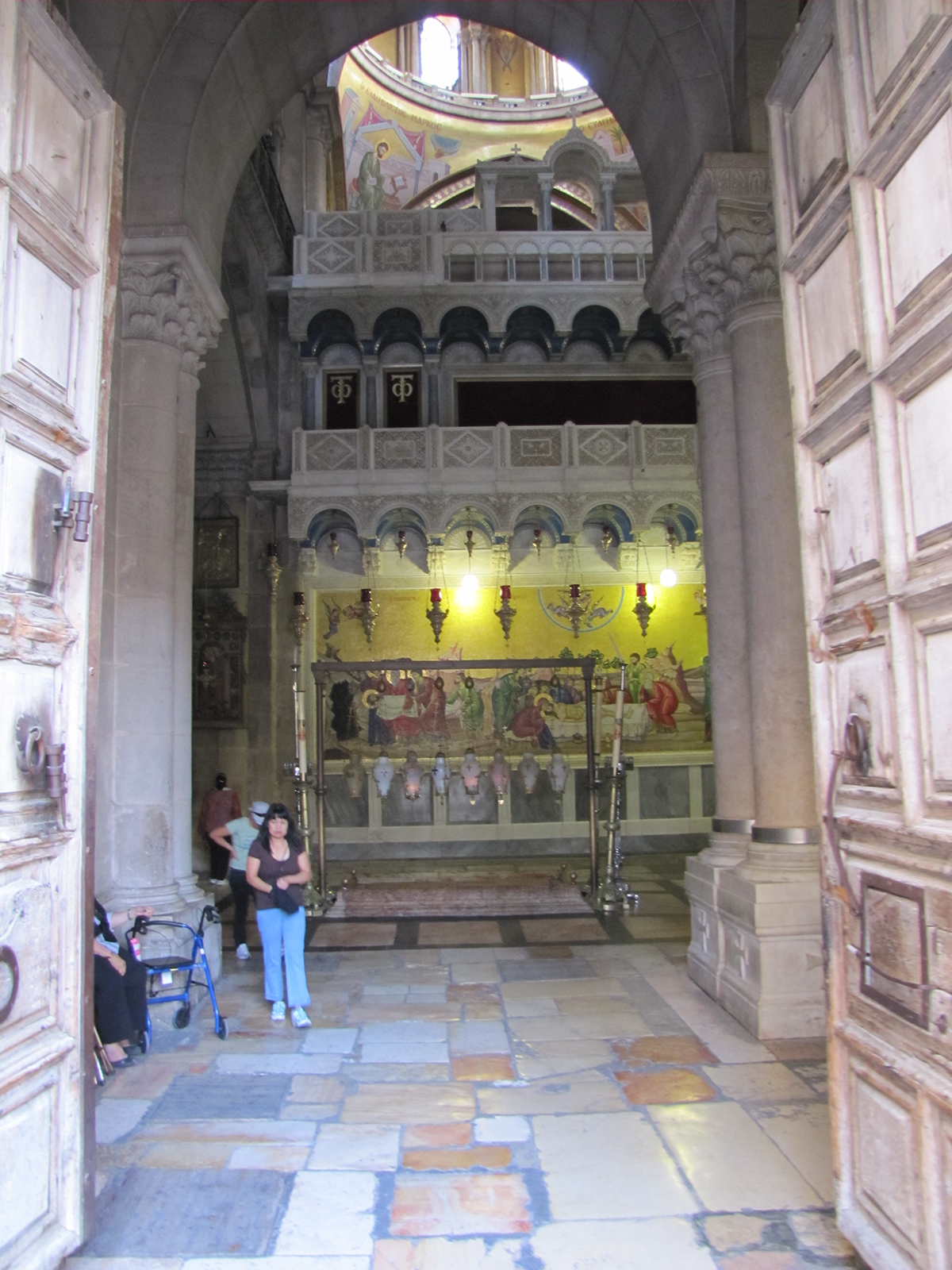
This is the view standing in the main entrance of the church. The doors for this entrance are on the left and right sides of the photo. On the floor directly in front is the Stone of Anointing where Jesus’ body was laid for anointing after he was taken down from the cross. Calvary is directly to the right about five more steps into the building. The tomb of Jesus is to the left of the anointing stone, about 70 steps away. The anointing stone was placed between Calvary and the tomb, in the general area where Joseph would have wrapped Jesus’ body and women may have applied the spices. The stone that is here today dates to 1808 when it was put here to replace the crusader period stone that was destroyed by fire.
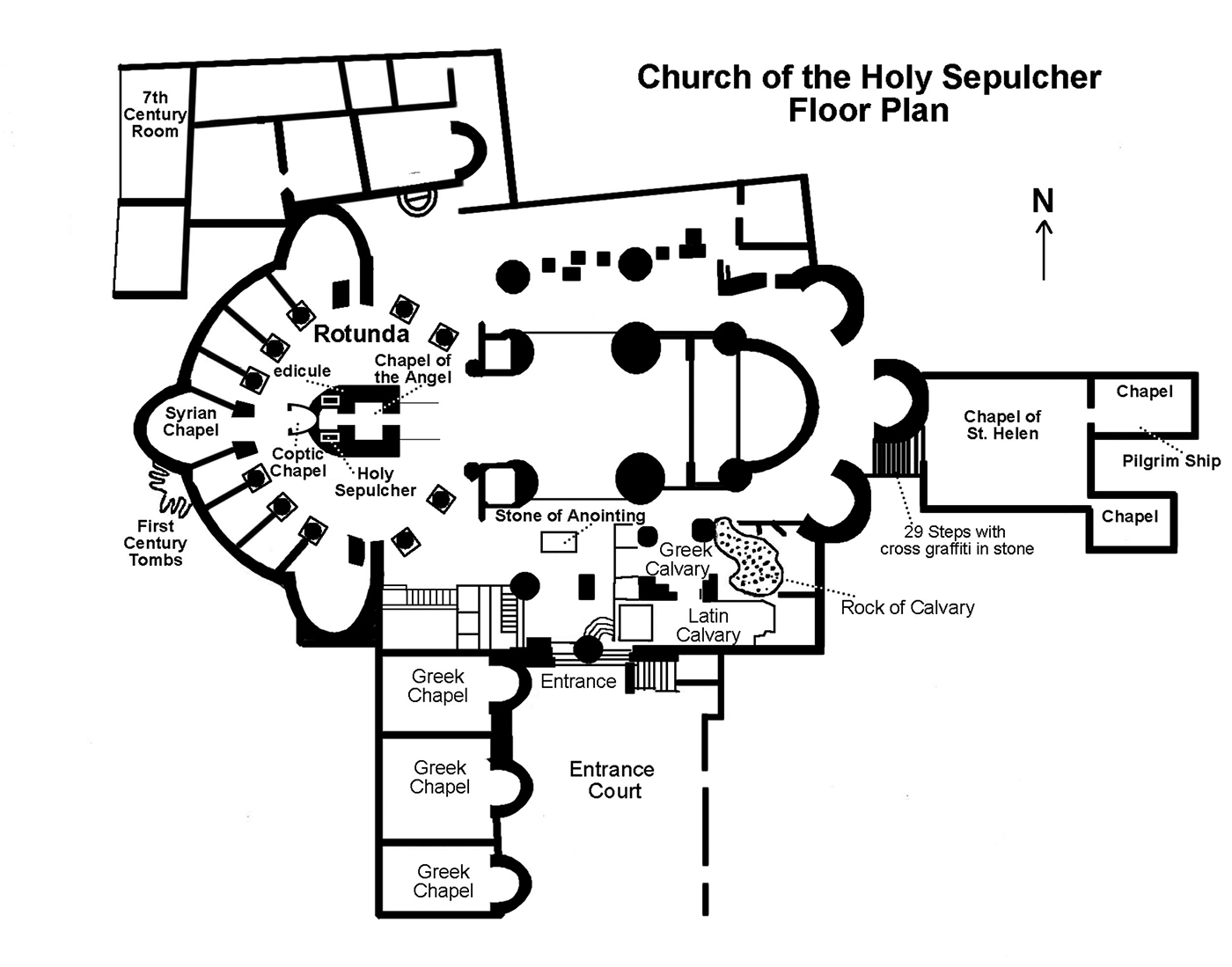
This is a floor plan of today's Church of the Holy Sepulcher. Locate the "Entrance" (right above the “Entrance Court) and the unblocked door seen above.
Some areas we will visit in the next few photos are:
1) the steps up to Calvary located behind the blocked entrance
2) the two views of Calvary up stairs that are called “Latin Calvary” and “Greek Calvary”
3) the “Chapel of Adam” (directly below the Greek Calvary, but not marked on this diagram)
4) the “Stone of Anointing” in the main entryway
5) the “Rotunda” with columns and an arched dome
6) the “Holy Sepulcher” and the burial bench of Jesus
7) the “Syrian Chapel” with access to “First Century Tombs”. We will then move to the right side of the diagram passing through some unmarked hallways and chapels to
8) the “29 Steps with Cross Graffiti”, down into the
9) “Chapel of St. Helen.” We will then return to the “Entrance” to watch the Muslim gate keeper lock the door of the church at the end of the day for the divided Christian groups who worship here.
This is the Roman Catholic, or Latin, Chapel next to Calvary. It is upstairs and to the right of the main entrance. A few steps ahead and to the left we enter the Greek Chapel, or the Greek Orthodox altar at Calvary. The altar you see here was made in Florence, Italy in 1588 and was donated by Cardinal Medici. On the front of the altar are four scenes from Jesus’ suffering hammered into silver panels – two panels are on the bottom and the other two are directly above them.
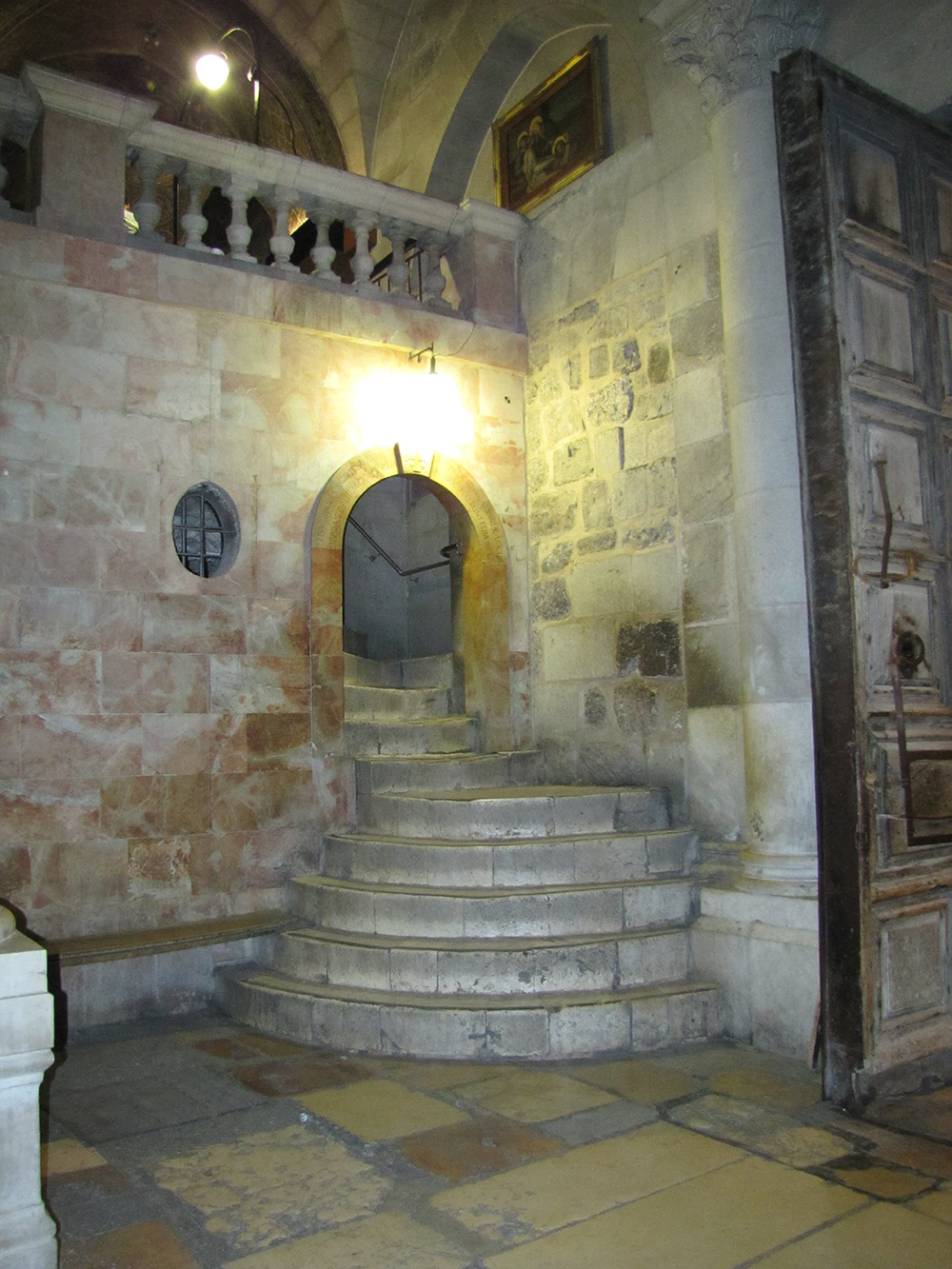
These are the eighteen steps up to Calvary. The steps are directly behind the blocked doorway at the front of the church. The steps are worn with dips, and the stairs tilt to the left. The rock of Calvary is located a few feet on the other side of this wall. At the top of the stairs we emerge into the Roman (Latin) Catholic Chapel for Calvary.
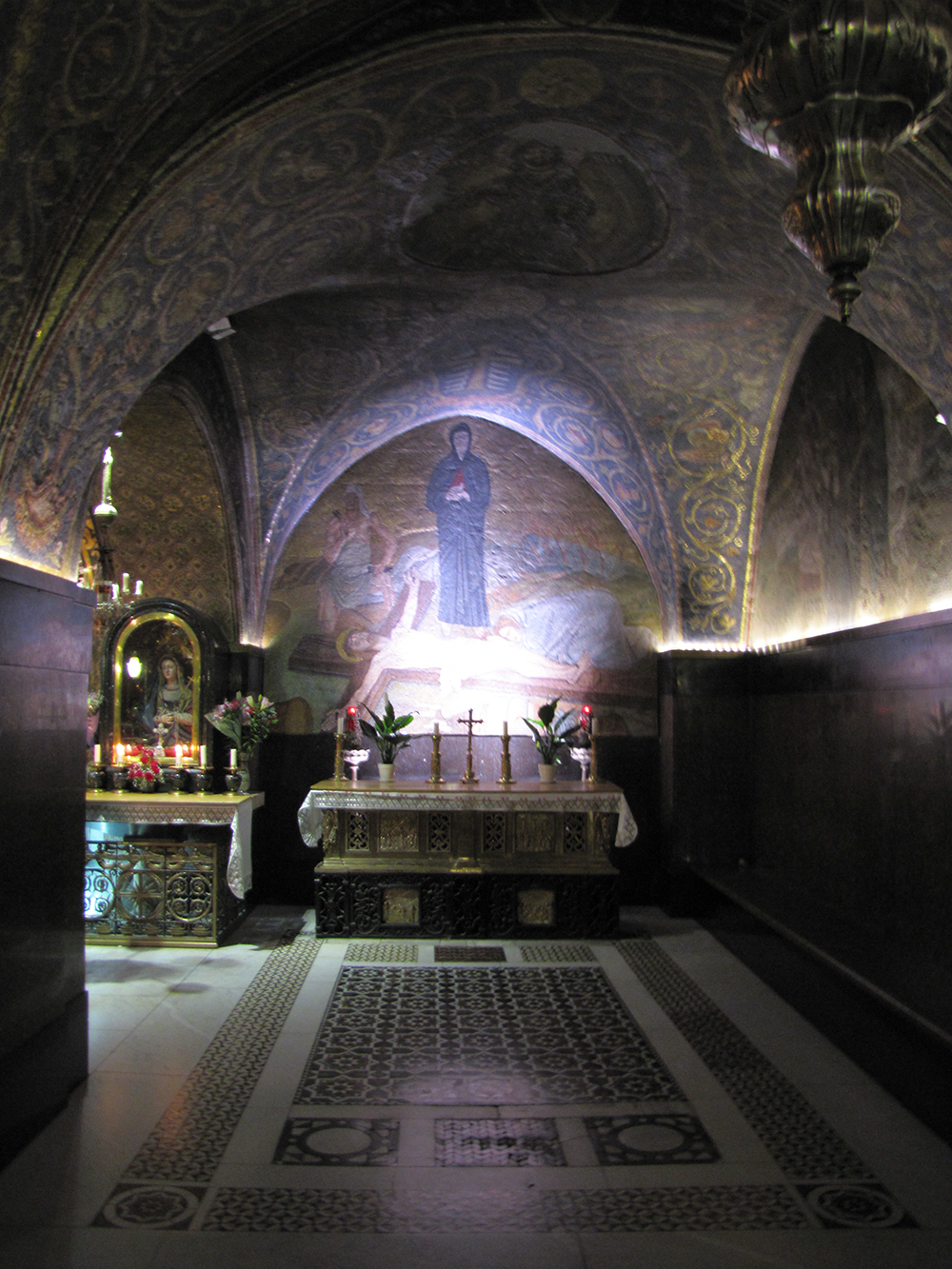
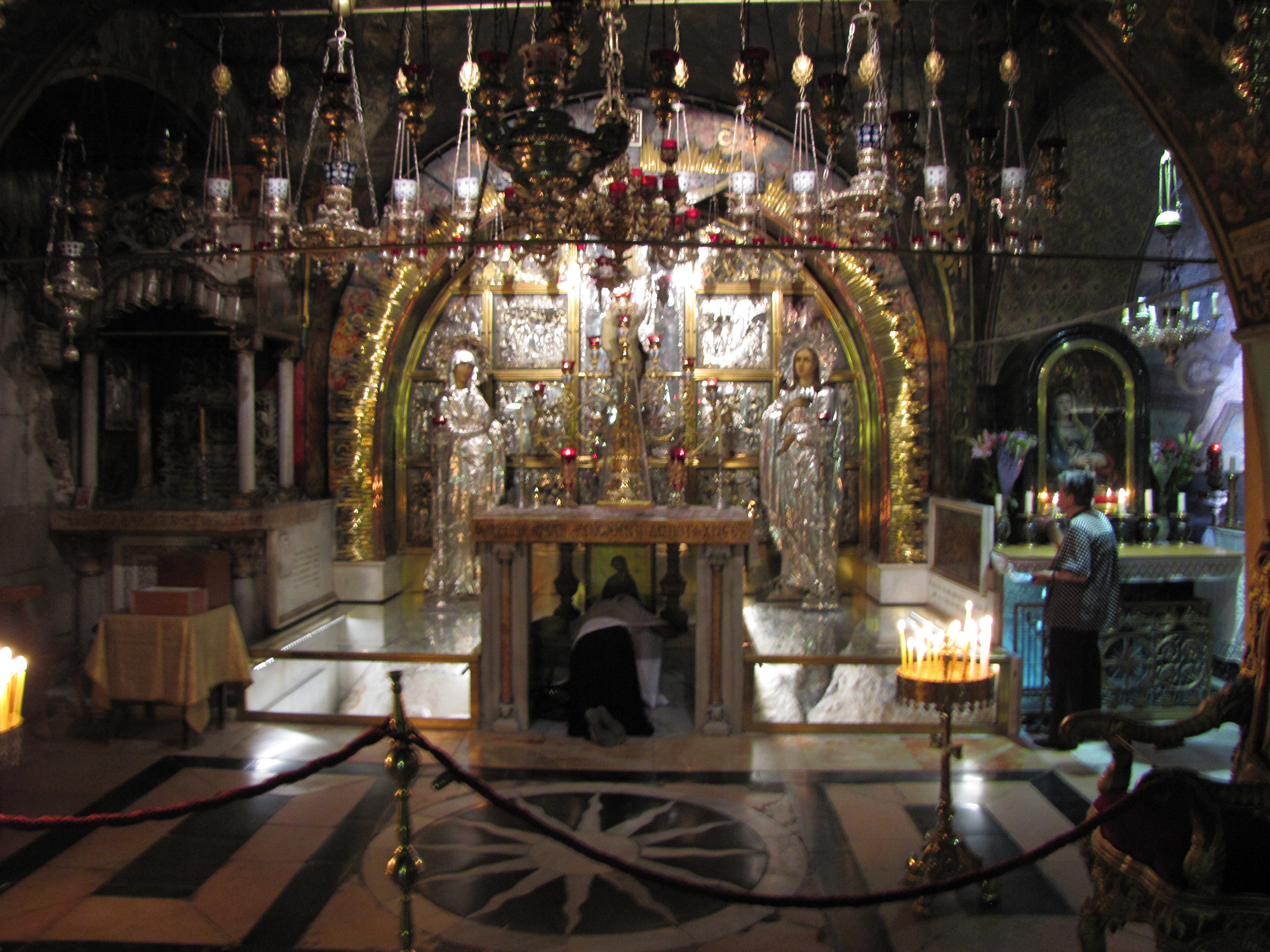
This is the Greek Altar in the Greek Chapel at Calvary (notice in the room to the right is the Roman Catholic Chapel). Underneath the altar and just in front of the picture (by the head of the person who is kneeling) is an opening through which you can actually touch the bedrock of Calvary at a spot that is traditionally believed to be near the place where the base of the cross was placed. On both sides of the altar the original bedrock of the rock known as Calvary (Golgotha or “The Skull”) can be seen through the viewing glass. The glass is there because, through the centuries, visiting pilgrims have chipped off souvenirs from these holy sites, including the original burial bench in Jesus’ tomb.
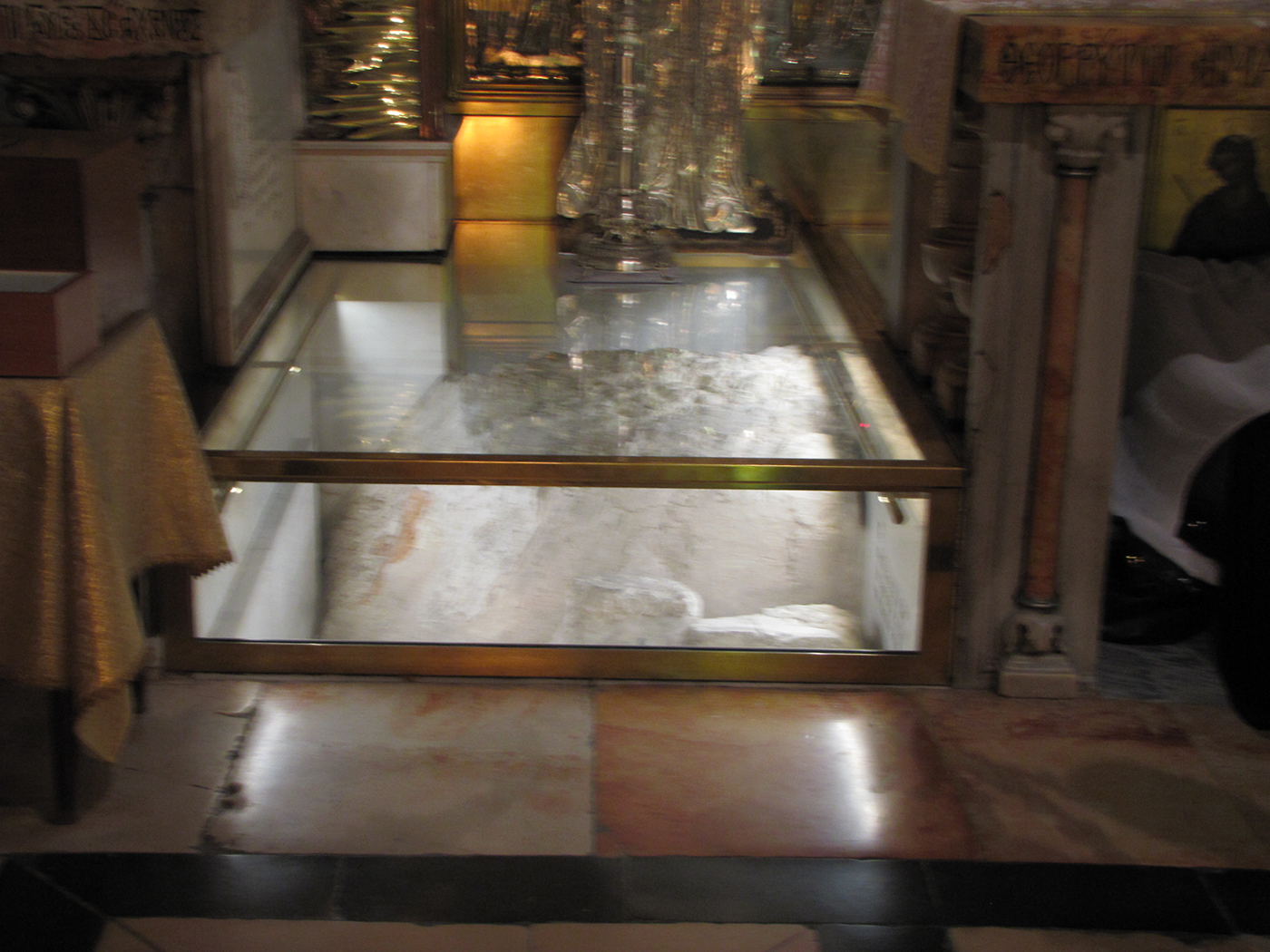
Carrying his own cross, he went out to the place of the Skull (which in Aramaic is called Golgotha). Here they crucified him. ...for the place where Jesus was crucified was near the city. - John 19:17, 18, 20
This is a close view of Calvary's stone on the right side of the Greek altar in the Greek Chapel. The base of the cross would have stood in one of the many holes chiseled into the rock that were left from the time when it was a quarry located just outside the city walls.
During the Byzantine period many of the traditions (both true and merely legendary) that had been associated with the Temple Mount were transferred to the Church of the Holy Sepulcher. For example, Adam was said to be buried beneath the cross on Calvary, thus the meaning of “Golgotha” - the place of the skull.
Also, the sacrifice of Isaac was transferred from the Temple Mount to the Holy Sepulcher. With the building of the Dome of the Rock on the Temple Mount, these traditions were transferred back to the Temple Mount by the Muslims.
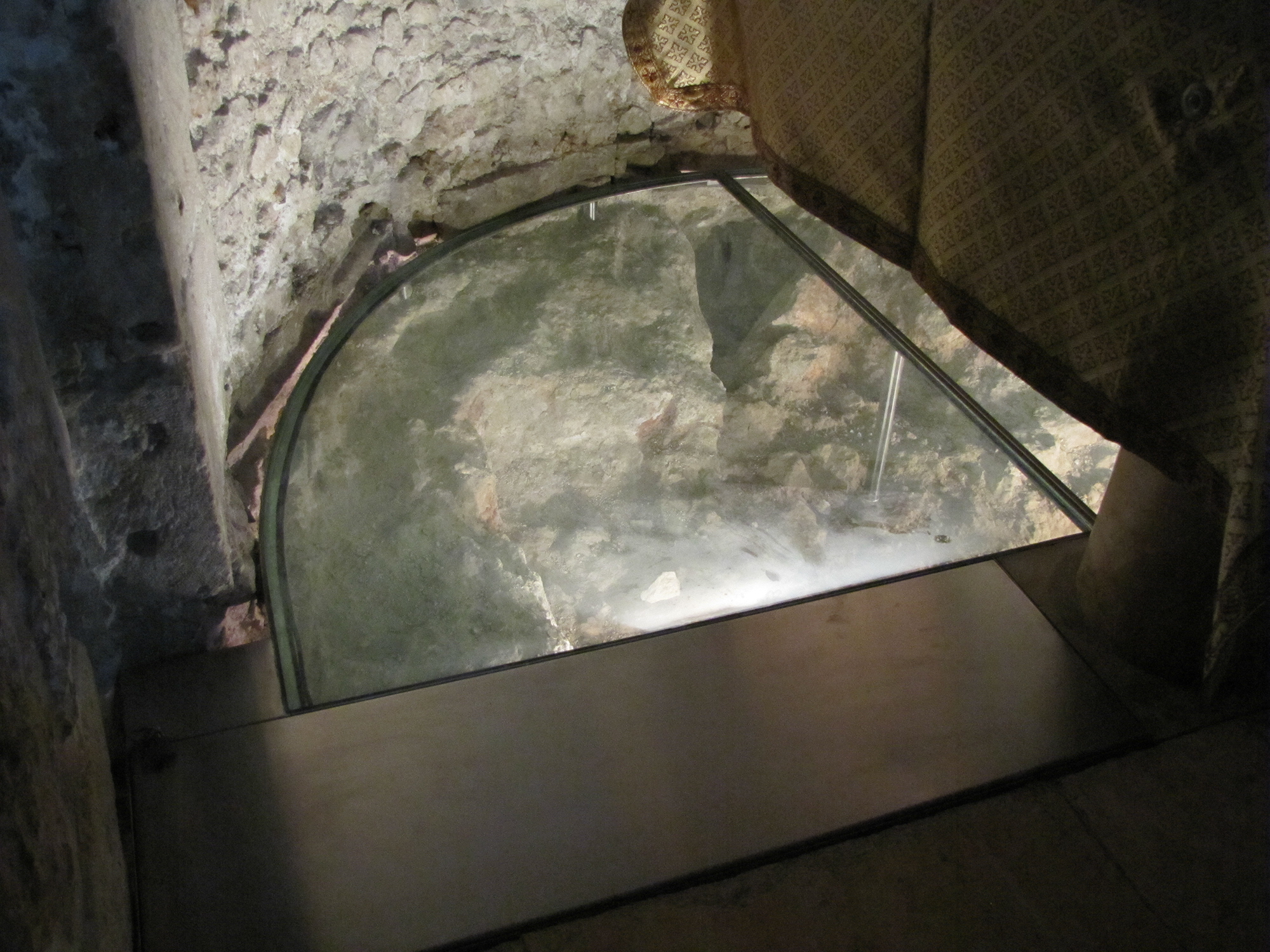
Down the stairs and directly below the Greek Chapel at Calvary is another chapel called The Chapel of Adam.
Here again we see more of the stone of Calvary in a viewing case. There is a crack in this rock that tradition says was caused by the earthquake that occurred when Jesus died, but archaeologists and geologists say the crack is an original flaw that would have rendered it useless for making blocks. That is why it (Calvary) was left in the quarry. It was rejected by the builders.
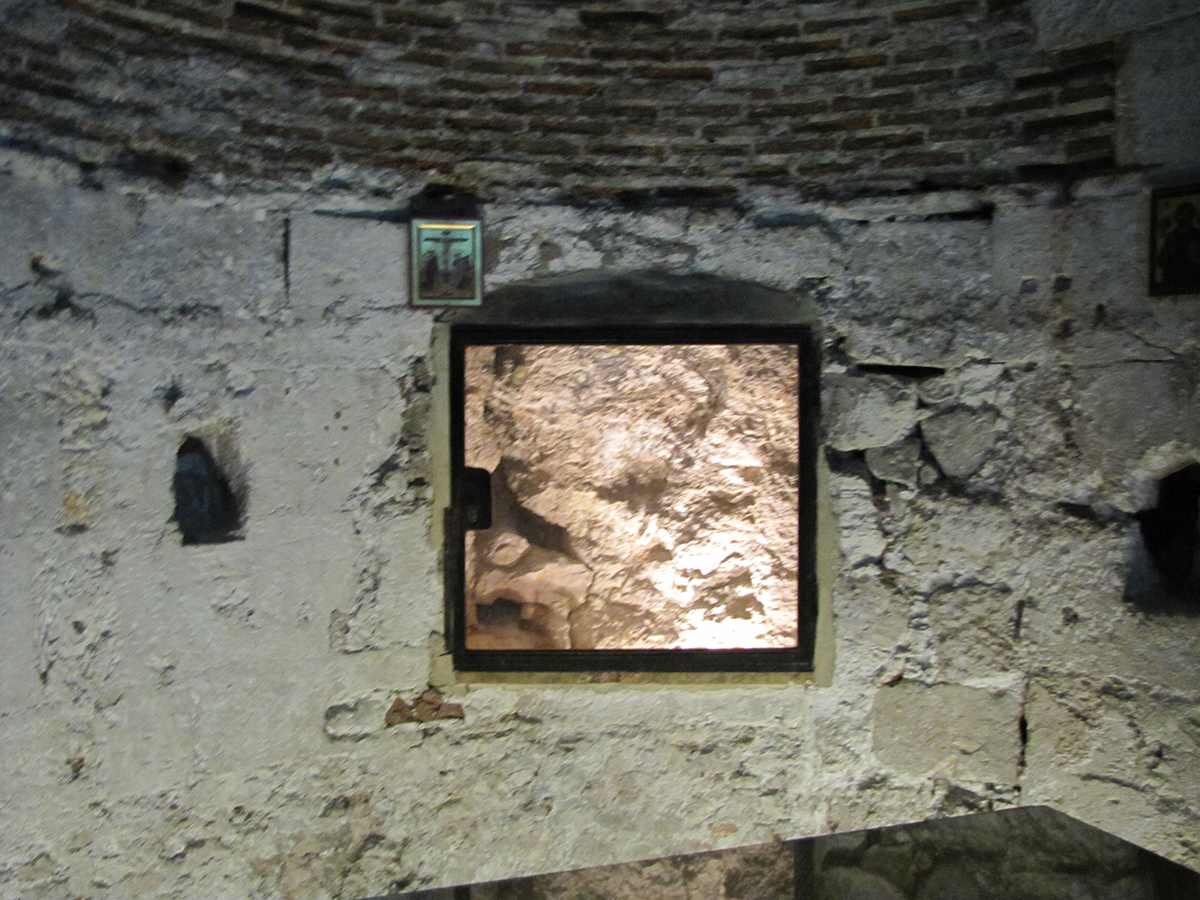
Through the glass case on a wall of the Chapel of Adam we can see a side view of the rock called Calvary.
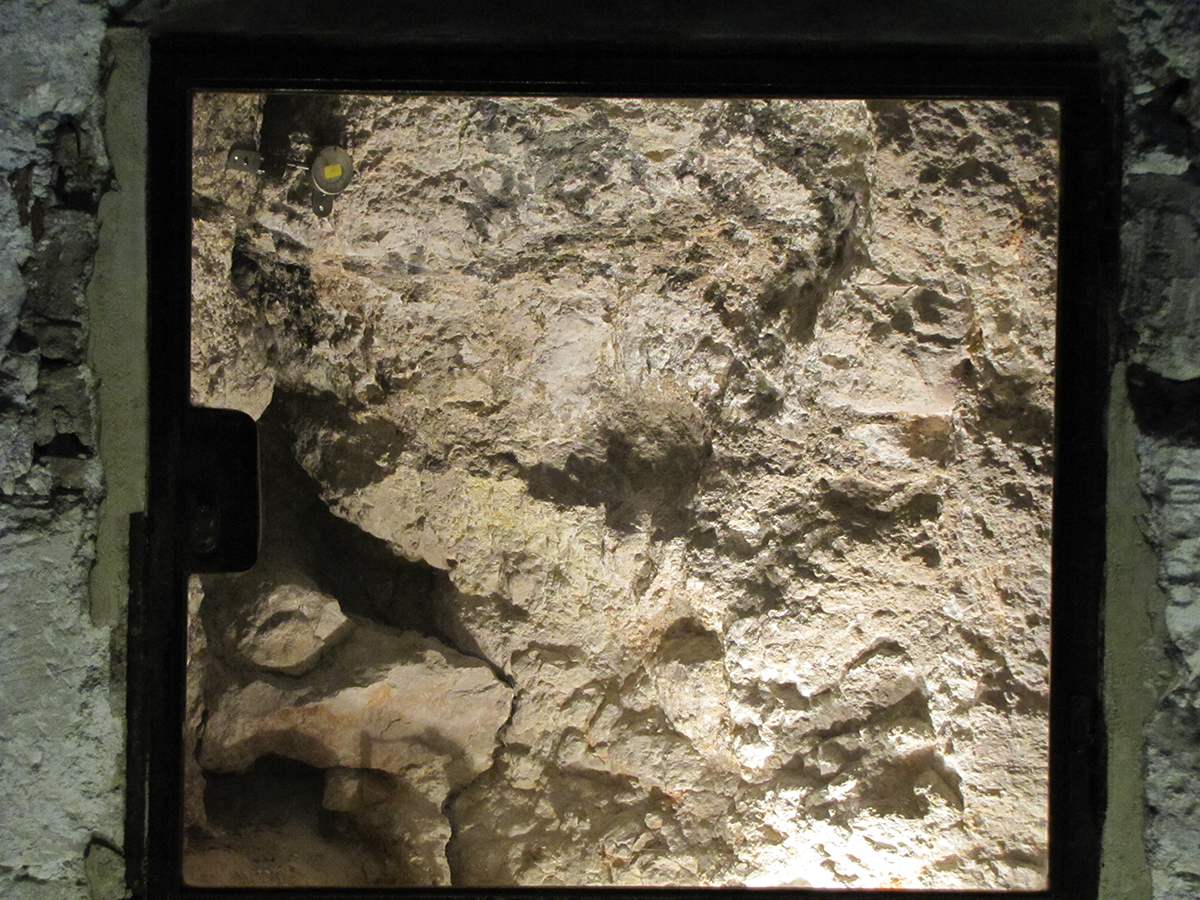
This is a close up of the rock of Calvary as seen through the wall in the Chapel of Adam. We are back on the main floor in the Chapel of Adam. We will leave this room and turn left to walk to the tomb of Jesus, going past the Stone of Anointing, which would be very close to the place Joseph and Nicodemus wrapped Jesus’ body: As evening approached, there came a rich man from Arimathea, named Joseph, who had himself become a disciple of Jesus. ...Joseph took the body, wrapped it in a clean linen cloth, and placed it in his own new tomb that he had cut out of the rock. He rolled a big stone in front of the entrance to the tomb and went away. Mary Magdalene and the other Mary were sitting there opposite the tomb.- Matthew 27:57-61 So as evening approached, Joseph of Arimathea, a prominent member of the Council, who was himself waiting for the kingdom of God went boldly to Pilate and asked for Jesus’ body....So Joseph bought some linen cloth, took down the body, wrapped it in the linen, and placed it in a tomb cut out of rock.- Mark 15:42-46
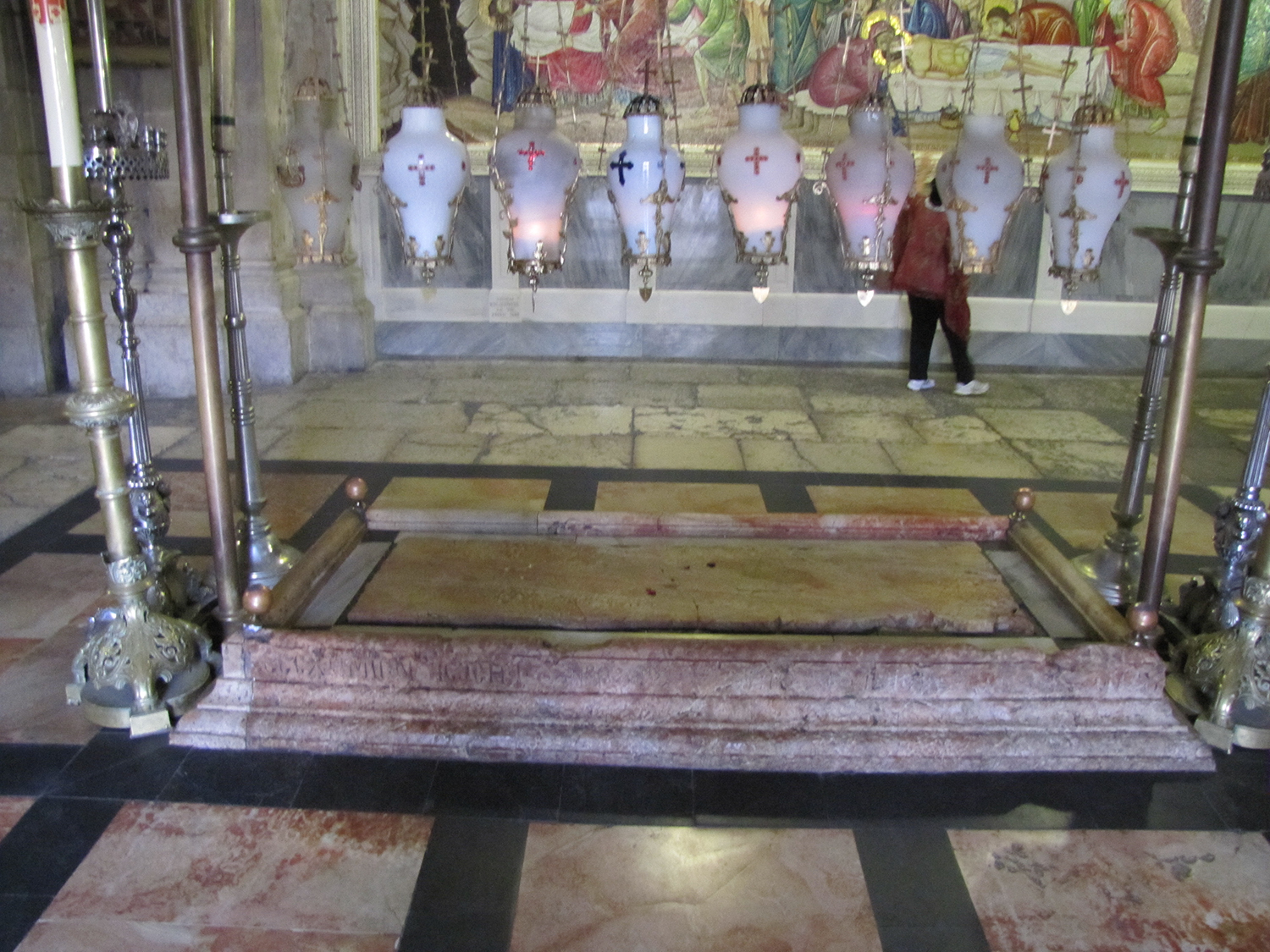
The Stone of Anointing between Calvary and the tomb. This stone was placed here 1810 after the fire of 1808 destroyed the previous stone that had been here since the time of the Crusaders in the 1100’s.
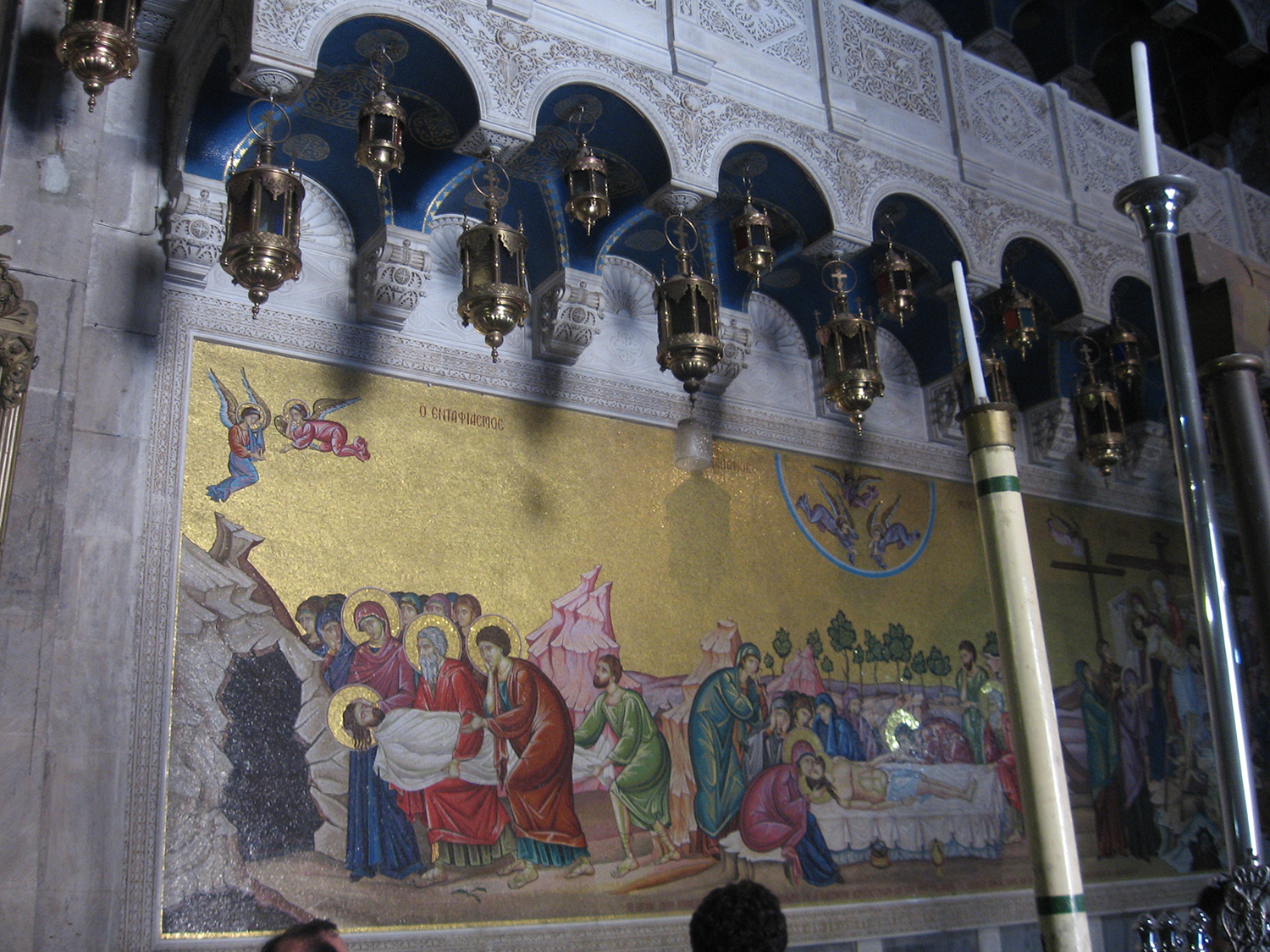
This modern Greek Orthodox mosaic hangs behind the Stone of Anointing and can be seen as we enter the Church of the Holy Sepulcher. The mosaic shows Jesus' body being removed from the cross with the skull of Adam in the ground beneath it (far right). This is why the chapel under the Greek Chapel at Calvary is called the Chapel of Adam. According to tradition, Adam was buried under Calvary when he died. But, an even earlier tradition has Adam being buried under the Most Holy Place on the Temple Mount. It appears this Jewish tradition followed the Christians from the Temple Mount to the Church of the Holy Sepulcher.
To the left of the Calvary scene is the middle scene, showing the anointing of Jesus’ body. The third scene, furthest to the left, is the burial of Jesus’ body in the tomb. All three of these events took place under the roof of the Church of the Holy Sepulcher.
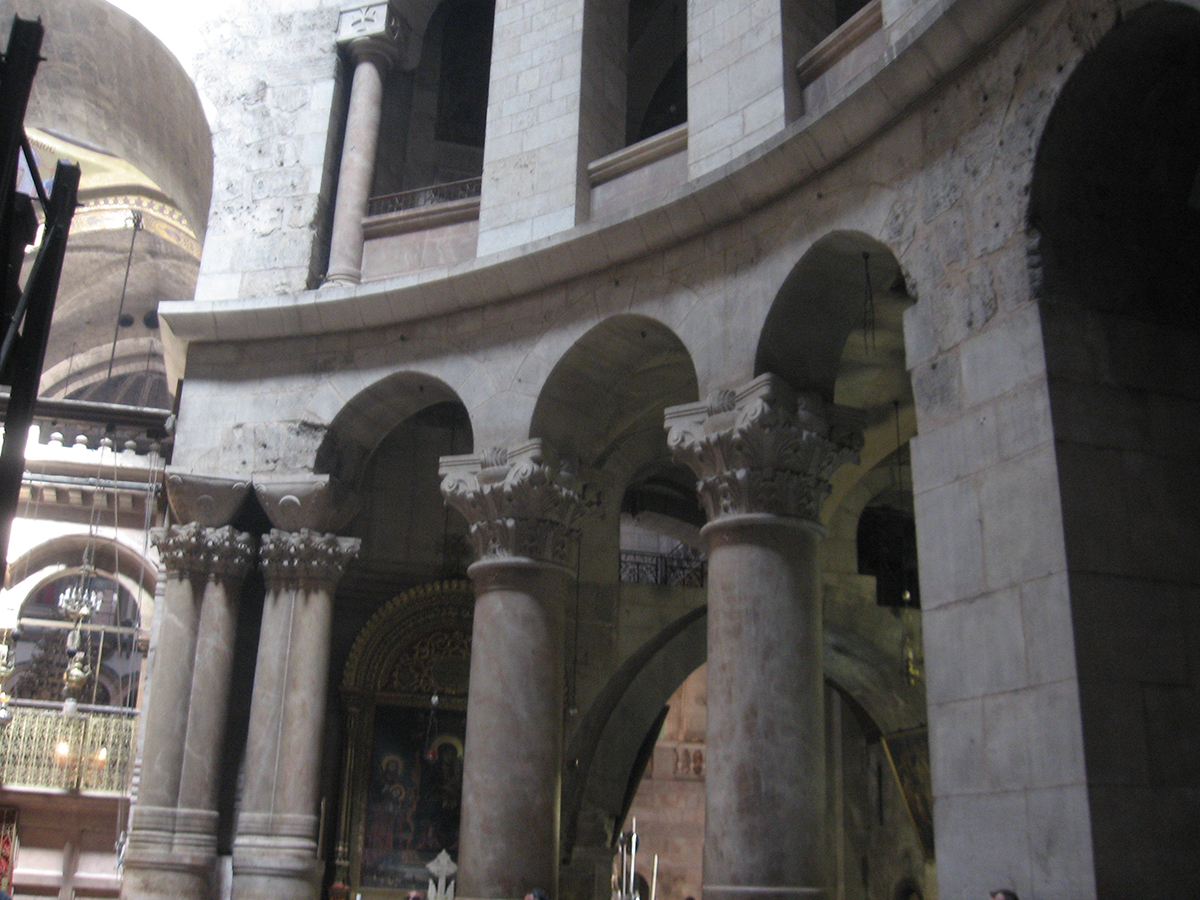
We enter the rotunda that encircles the tomb of Jesus. These are the columns at the front on the left side of the Rotunda.
The columns in today’s rotunda over the tomb of Christ are parts of Constantine’s original rotunda built in the 300’s. This means the original columns were taller and much more magnificent than what we see today.
Constantine’s spectacular rotunda with its large dome covering the tomb of Christ was intended to declare Christ’s victory and reign. Eusebius, the church historian from the days of Constantine, quoted Constantine as ordering a rotunda built for Christ that was “of a magnificence worthy of his wealth and of his crown.”
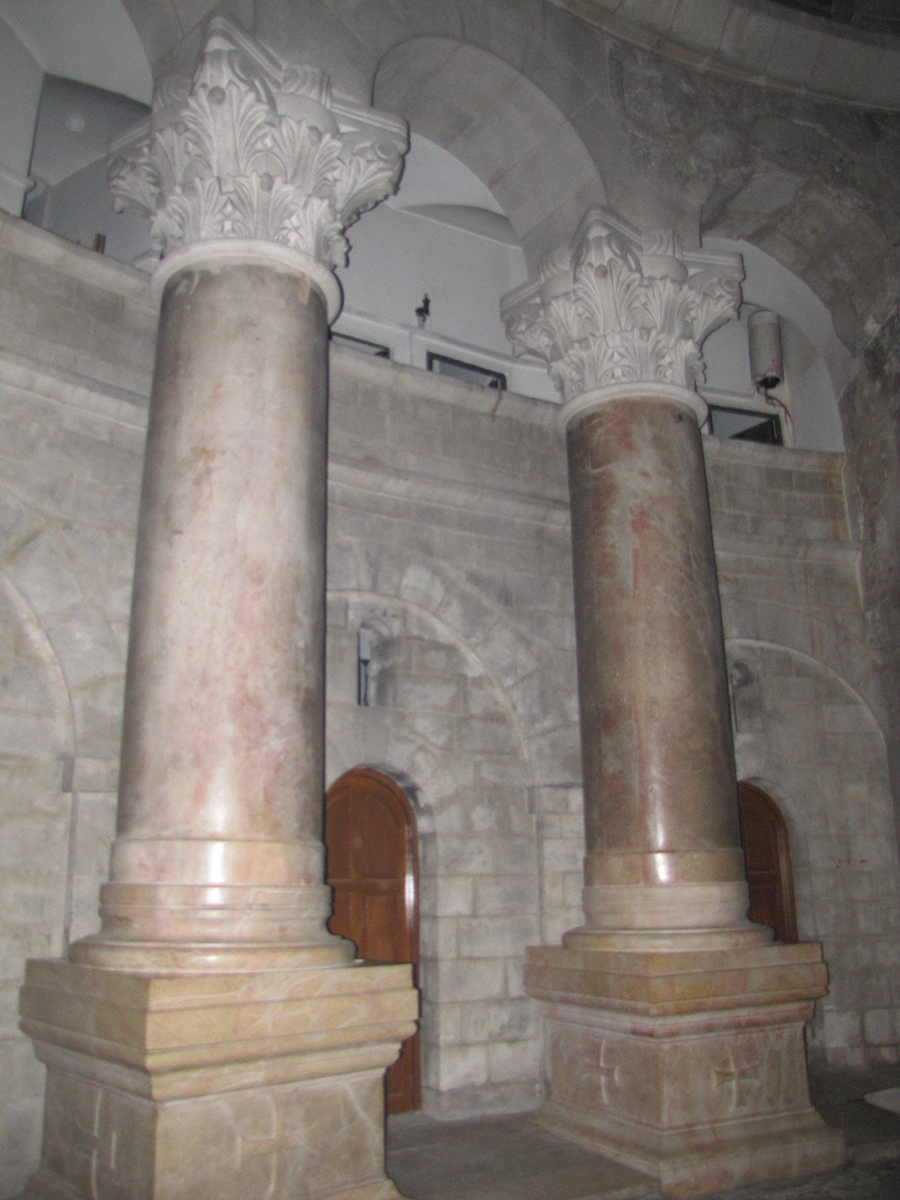
These columns are on the right side in the back of the Rotunda as we face the tomb.

These columns are on the left side toward the back of the tomb.
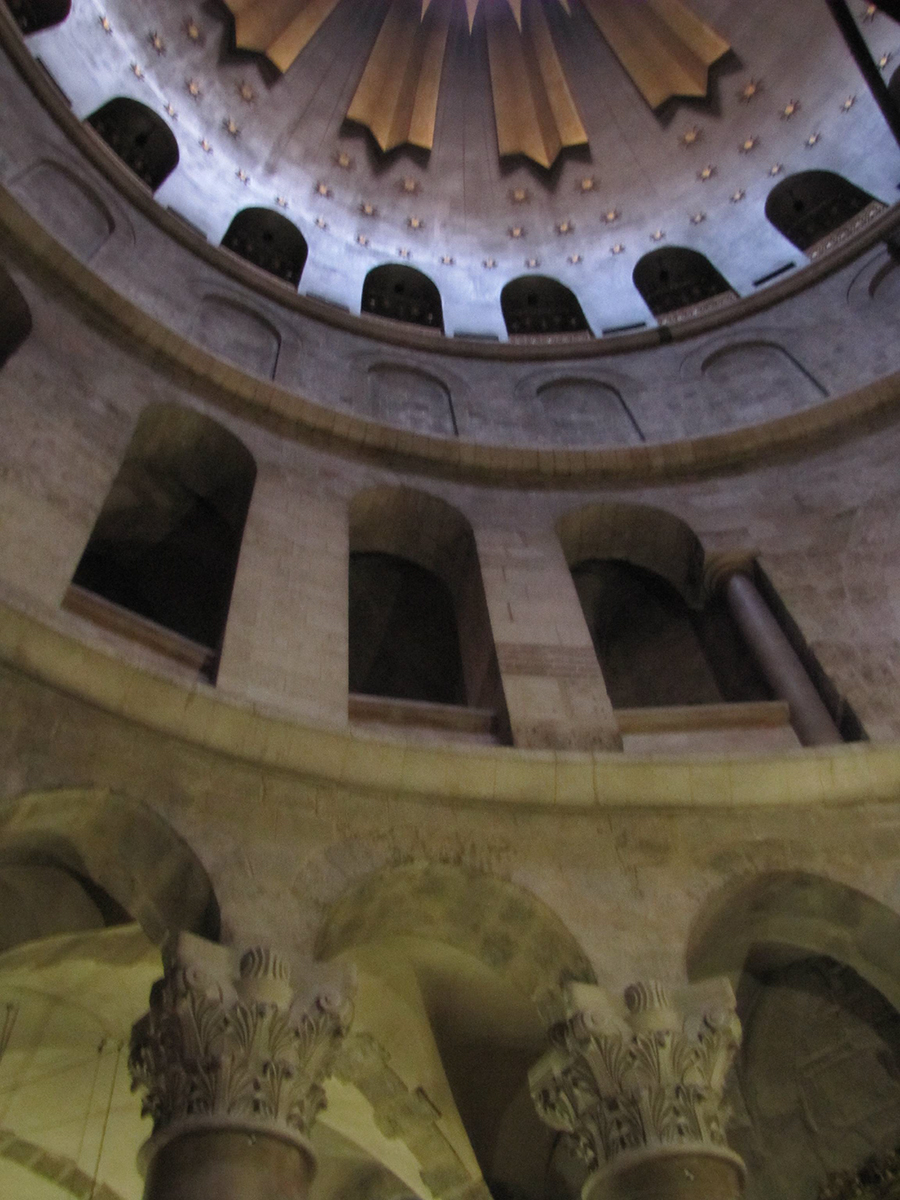
Columns, with the dome of the Rotunda above. This is inside the larger of the two grey domes of the Church of the Holy Sepulcher.
Originally, the Church of the Holy Sepulcher was constructed as two sites. The first was a rotunda (a building with a circular ground plan) with a dome marking the tomb of Christ. The second was a basilica church on the site of the crucifixion. (A basilica is large-roofed hall with interior colonnades that divides the space, giving aisles or arcaded spaces at one or both sides. There is also an apse at one end where the church leaders sit. The central aisle is usually wider and higher than the flanking aisles. This design allows light to enter through the clerestory windows, the upper row of windows, in order to bring light all the way to the center of the large building).
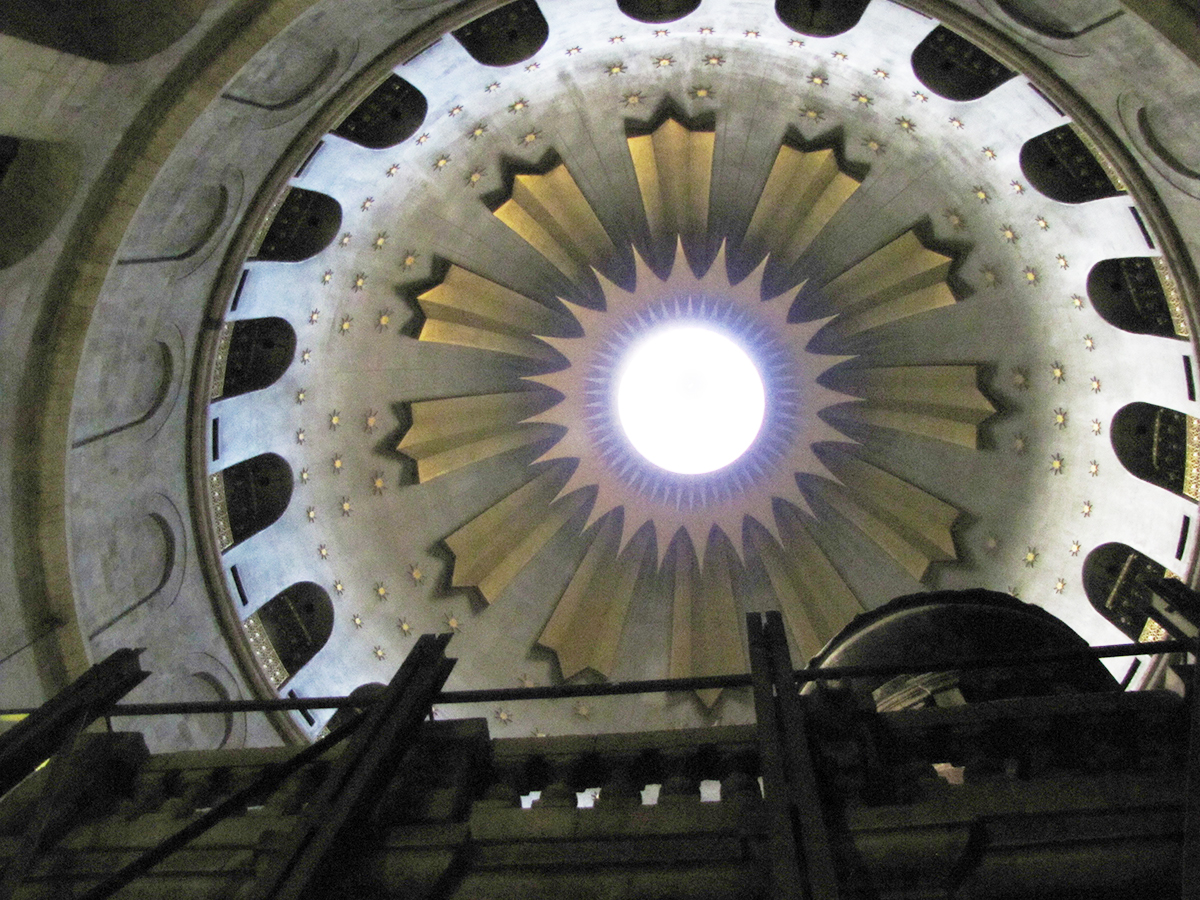
The dome of the Rotunda. This is the inside of the larger grey dome of the Church of the Holy Sepulcher.
Between these two buildings was a courtyard enclosed in a columned portico. All this was located on the west side of the Cardo, Jerusalem’s main street at that time. The Basilica faced the street and was the front entrance of the complex.
In 1876 a mosaic called the Madaba Map was found on the floor of a Byzantine church from the 500’s in Madaba, Jordan. This map shows the Cardo Street, the Nea Church and the Church of the Holy Sepulcher.
The full map was of Israel, and included the area from Beth-shan to the Nile River in Egypt, and from the Mediterranean Sea in the west to the Arabian Desert in the east. It is the oldest map of Israel in existence.
The map is about 65 feet by 16 feet, and was made from more than 2 million tesserae. There are 150 captions, all in Greek.
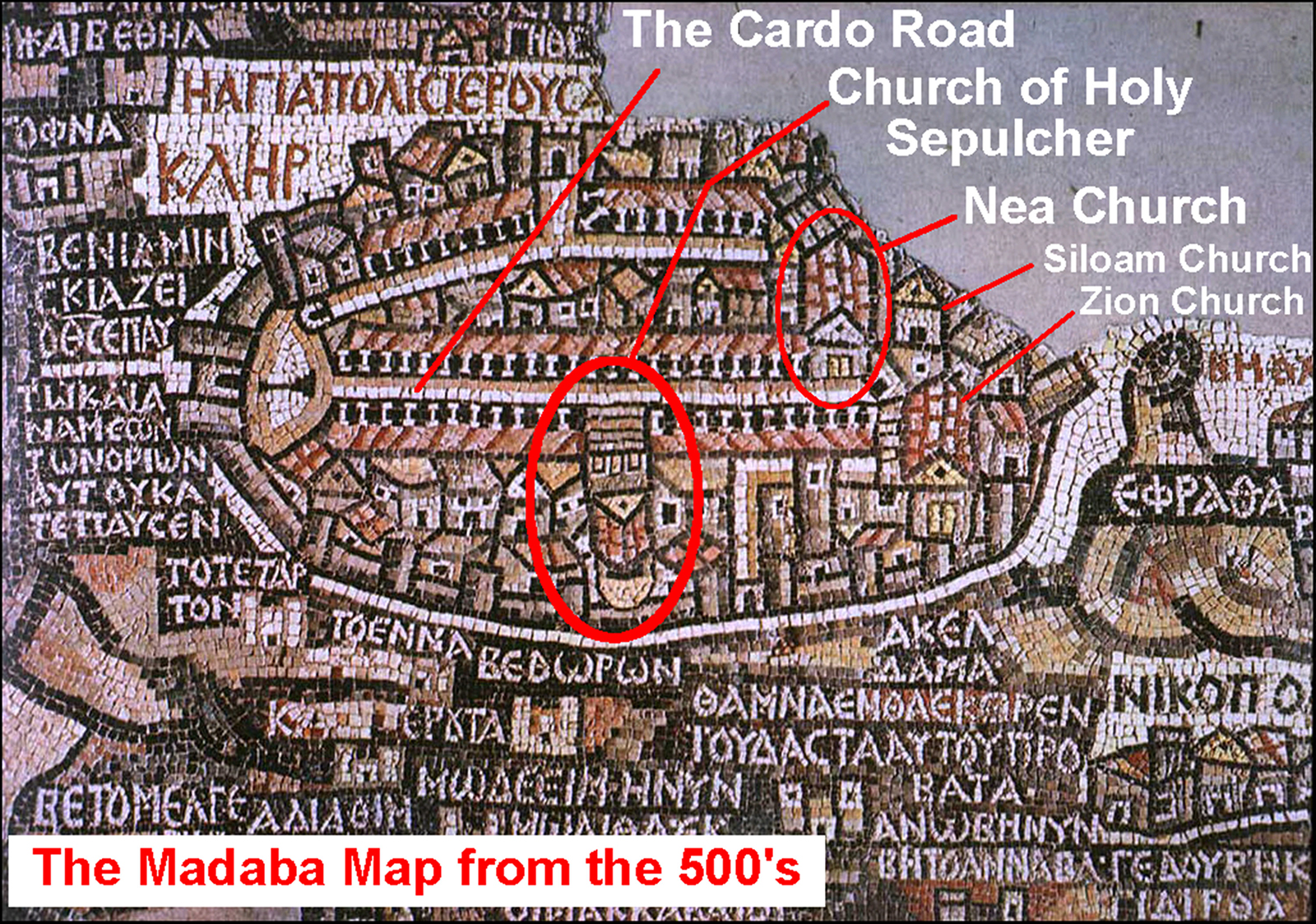
The Madaba map from the 500's AD shows the main Roman road called the Cardo with the most important Christian churches in relation to the Cardo. The Church of the Holy Sepulcher is shown with its basilica built in front of Calvary so that it extends all the way to the Cardo. Also, shown on the map are the Nea Church, the Siloam Church and the Zion Church. On Easter each year during the Byzantine era, a very large procession began at the Nea Church and progressed down the Cardo Street to the Church of the Holy Sepulcher.
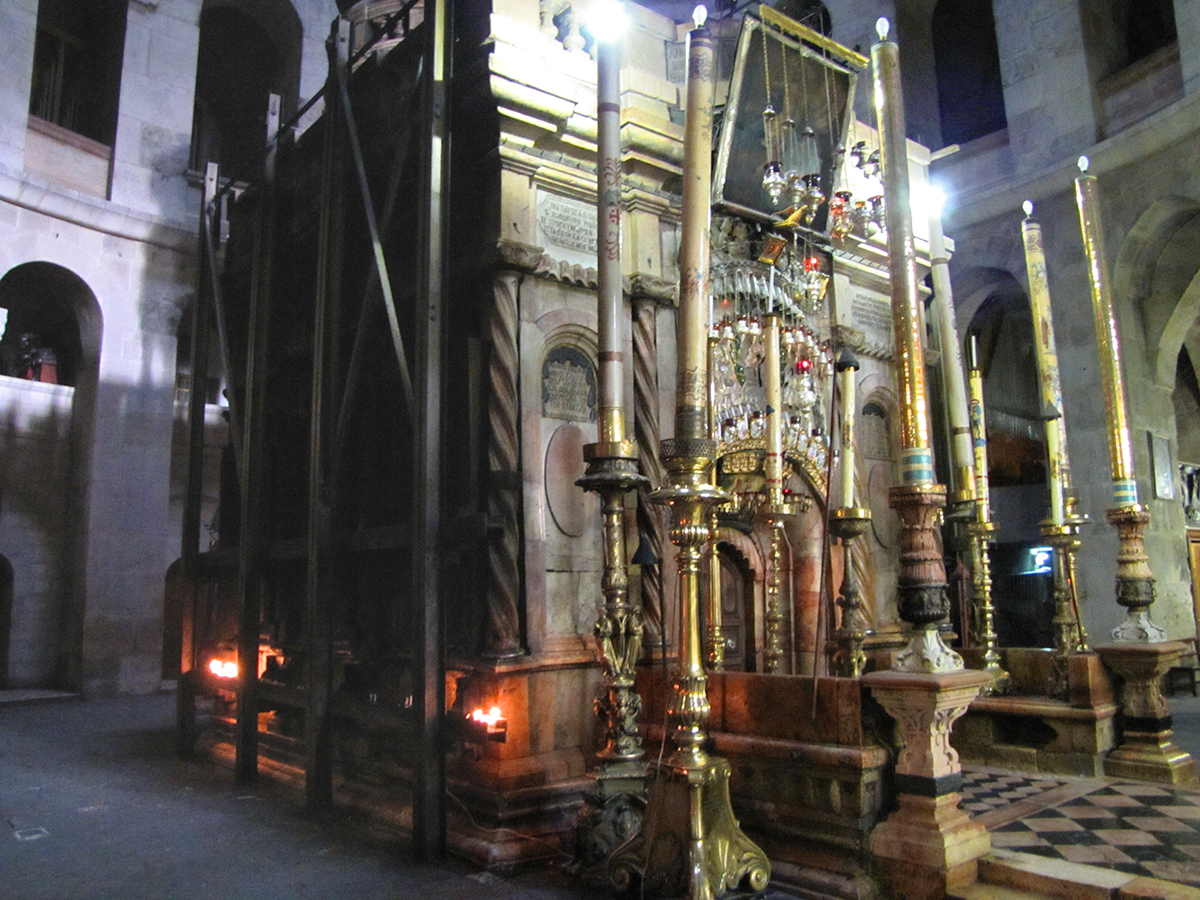
Right in the middle of the Rotunda is the Holy Sepulcher, the Tomb of Jesus. The original rock that surrounded the tomb was removed by Constantine beginning in 326 so that only a large square rock block was left surrounding the tomb. In 1009 the Muslim Caliph from Egypt, al-Hakim, completely destroyed the Church of the Holy Sepulcher and crushed the stone block around the tomb that was left by Constantine. The only portion of the tomb that was spared was the burial bench because it was covered in the rubble. Today the burial bench exists but is covered with a marble slab to preserve what is left from visiting Christians who chipped away at it in order to get a piece of the tomb.
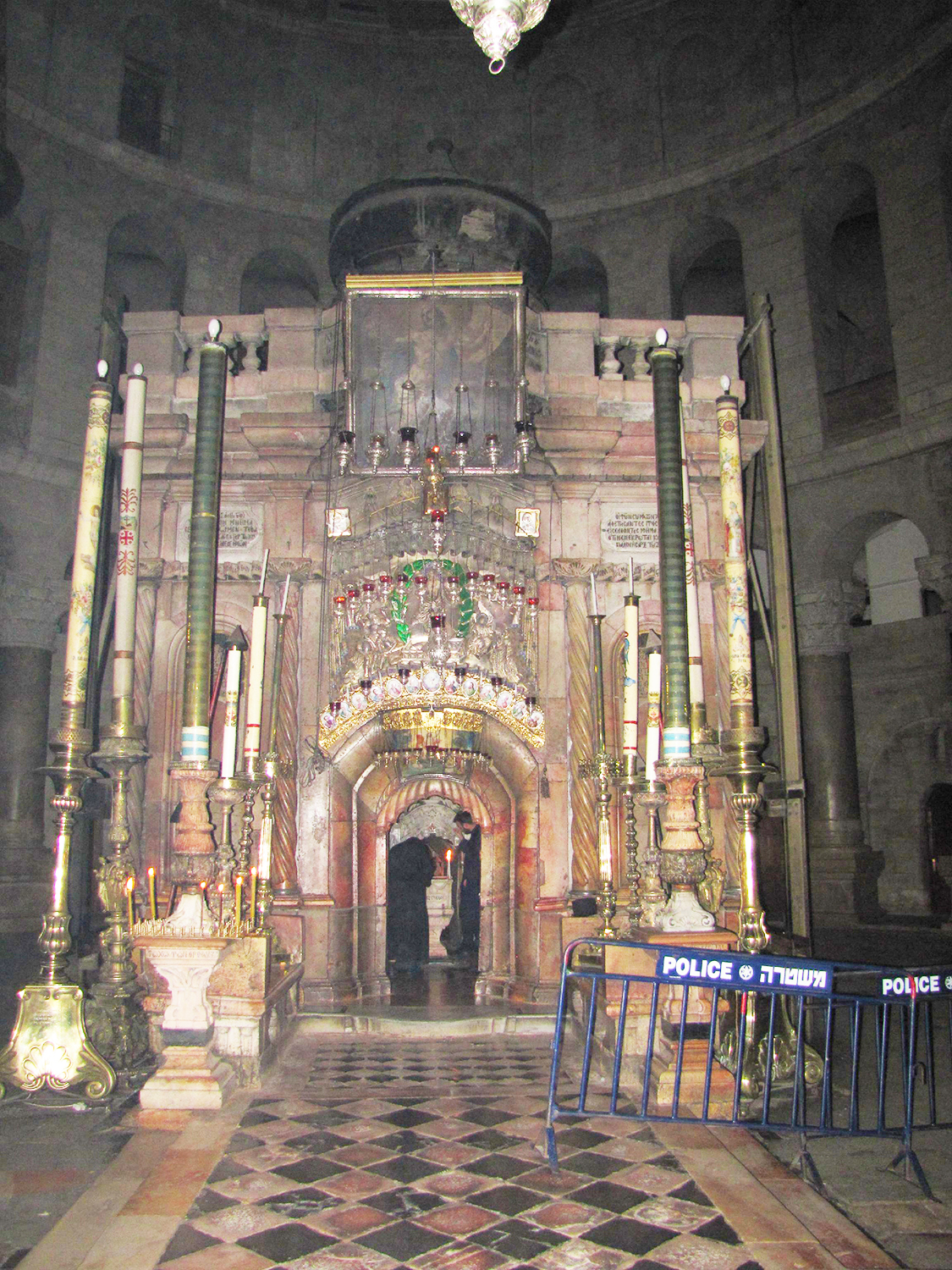
The front of the Holy Sepulcher. The only original part of Jesus’ tomb that is left is the burial bench in the back left of the elaborate building.
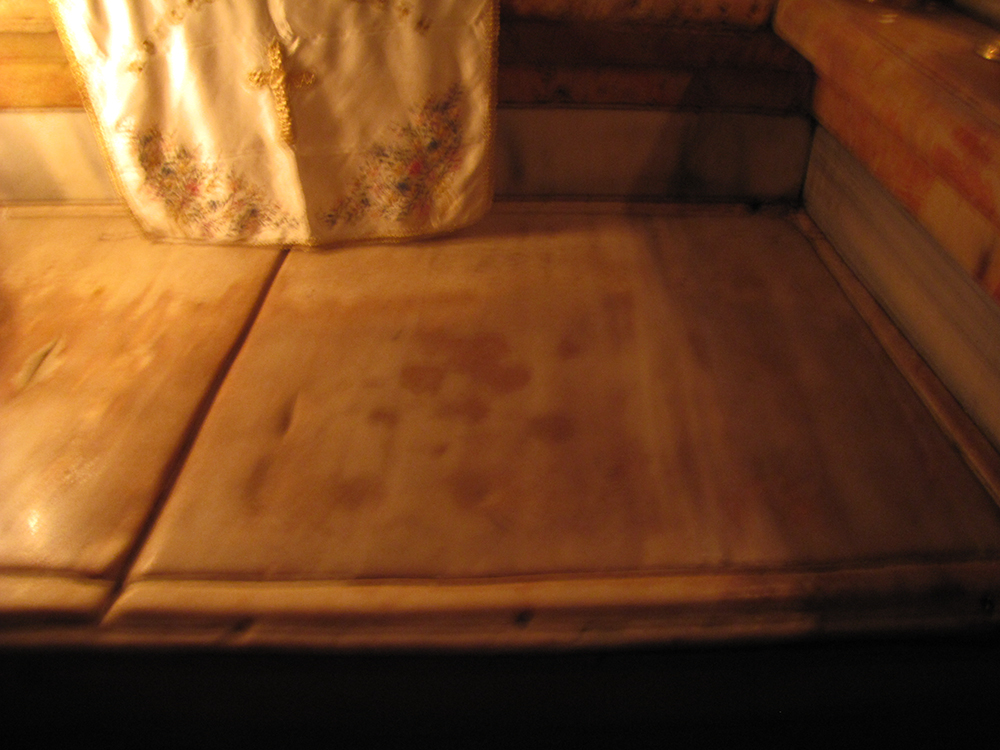
This is the marble slab that covers the burial bench of Jesus located in the Rotunda of the Church of the Holy Sepulcher. It was placed here in 1555. The split in the middle of the slab was put there on purpose to discourage Muslim looters during the Ottoman Empire.
Joseph took the body, wrapped it in a clean linen cloth, and placed it in his own new tomb that he had cut out of the rock. He rolled a big stone in front of the entrance to the tomb and went away. Mary Magdalene and the other Mary were sitting there opposite the tomb.- Matthew 27:59-61 (also Mark 15:46-47; Luke 23:53)
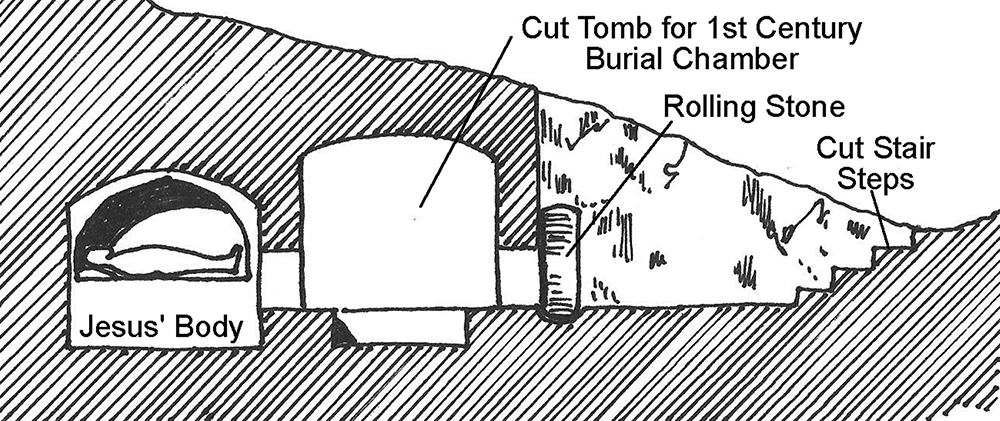
An image of what the tomb of Jesus originally looked like. The only part left is the burial bench.
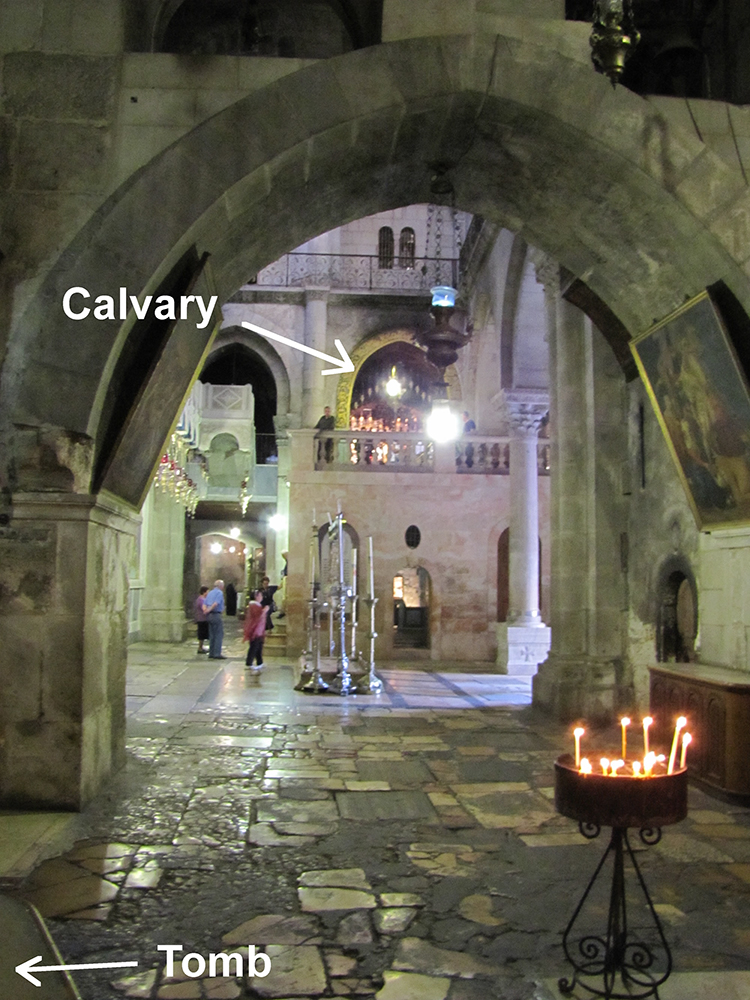
This photo provides a perspective of the distance between Calvary and the tomb of Jesus. This was originally a rock quarry that was abandoned and used for cutting tombs in the days of the New Testament. The Stone of Anointing is in the middle of this photo.
The nearness of Calvary to the tomb of Christ is attested to in the Gospel of John. John wrote that they were close together and located in the same garden:
At the place where Jesus was crucified, there was a garden, and in the garden a new tomb. -John 19:41
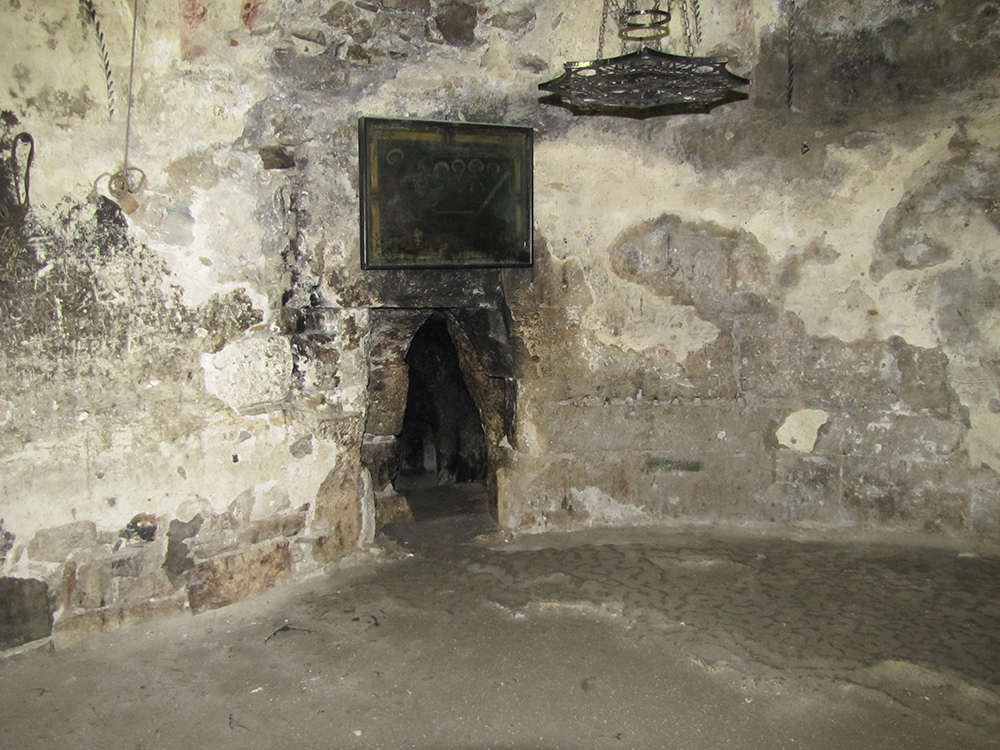
A small room behind the Rotunda, just a few steps from the tomb of Jesus, provides access to other tombs from the same period. In this picture is a small opening that leads to the long narrow tombs. In the next photo we will look inside this doorway. Then, we will crouch down and enter the tombs inside.
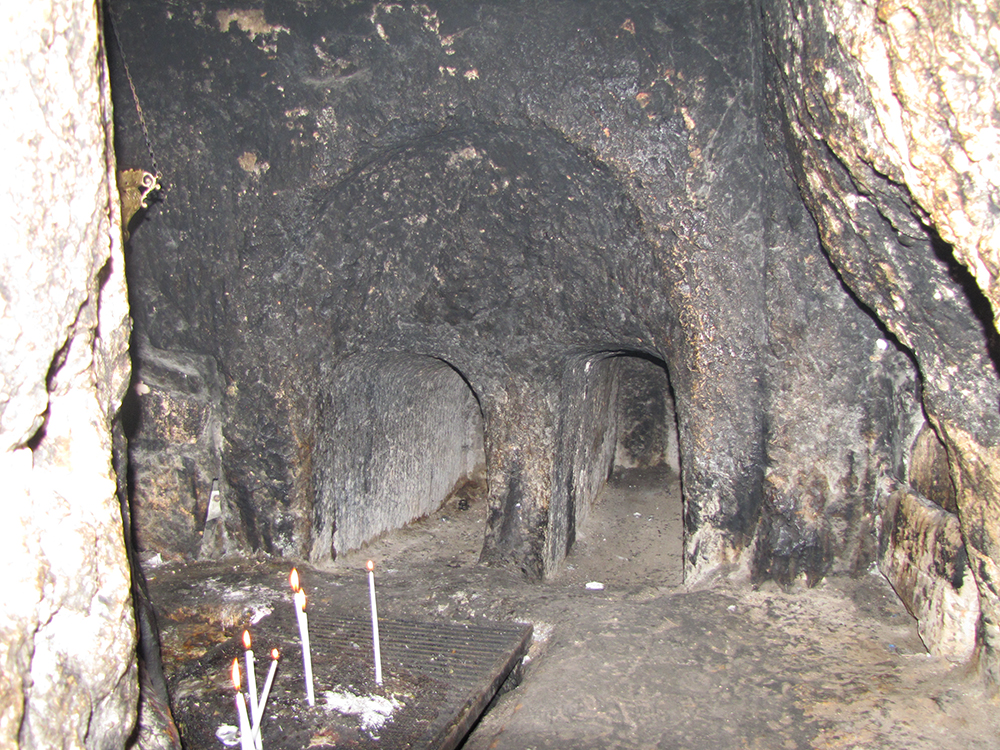
Inside the chamber we can see the long, narrow tombs. These are just a few feet from Jesus' tomb and are cut into the same rock.
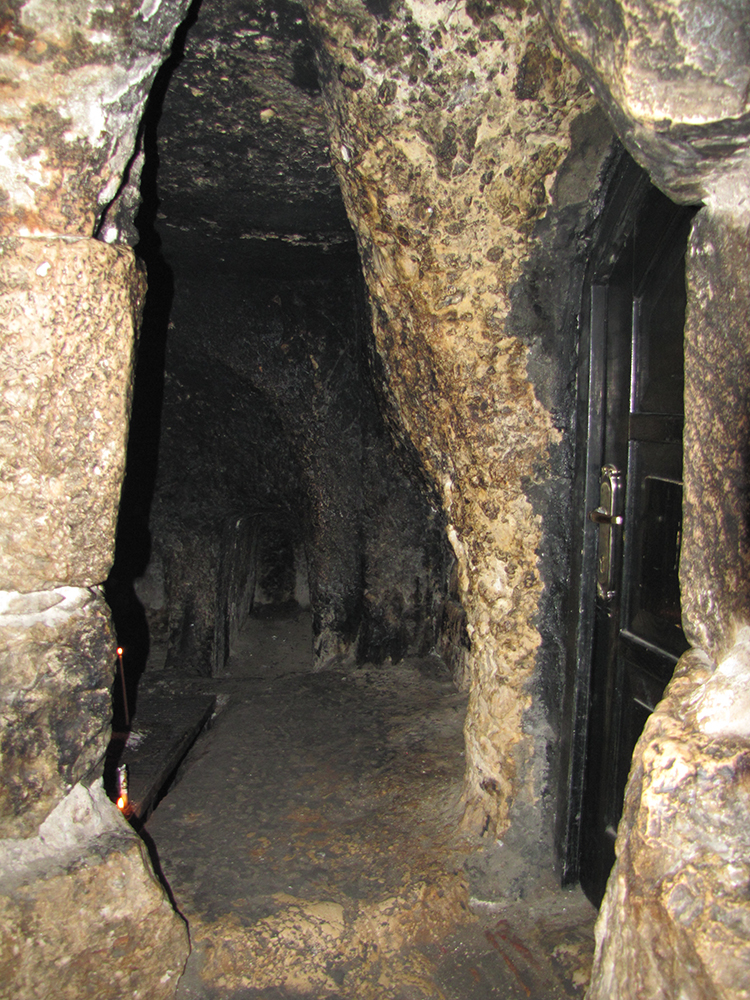
Inside the small opening we can see the original bedrock and tombs in the back. There is a small door to the right that blocks access into one of the tombs.
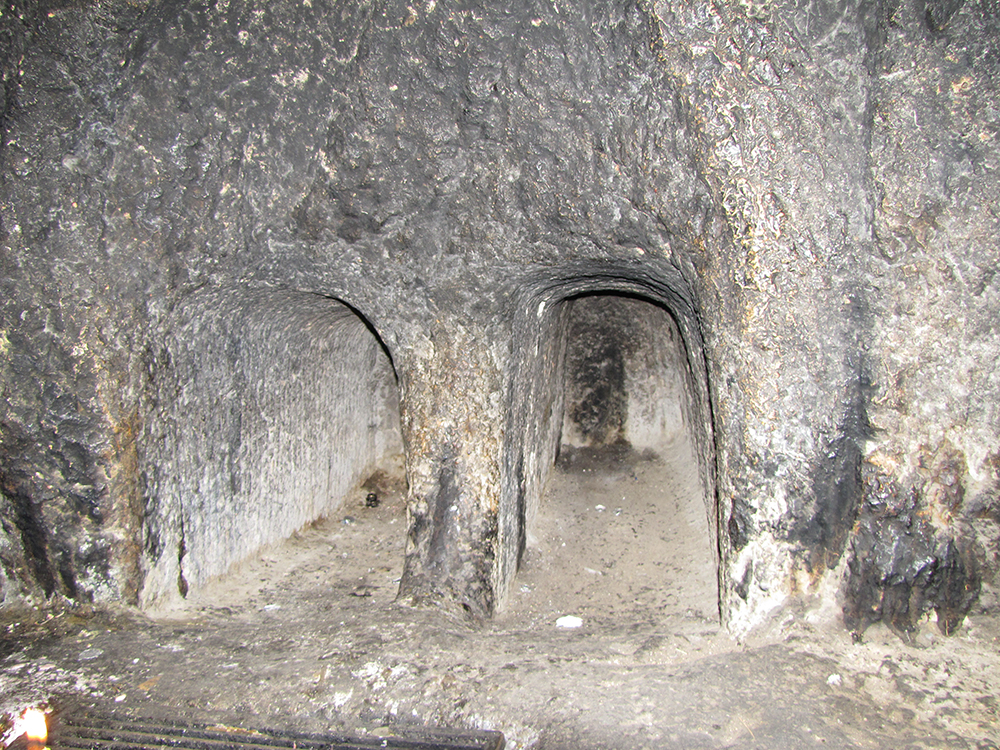
Here we look inside the areas where bodies were laid after they were wrapped in cloth and spices. After about a year, the body would have decayed, and the bones would then be collected and placed in an ossuary box.
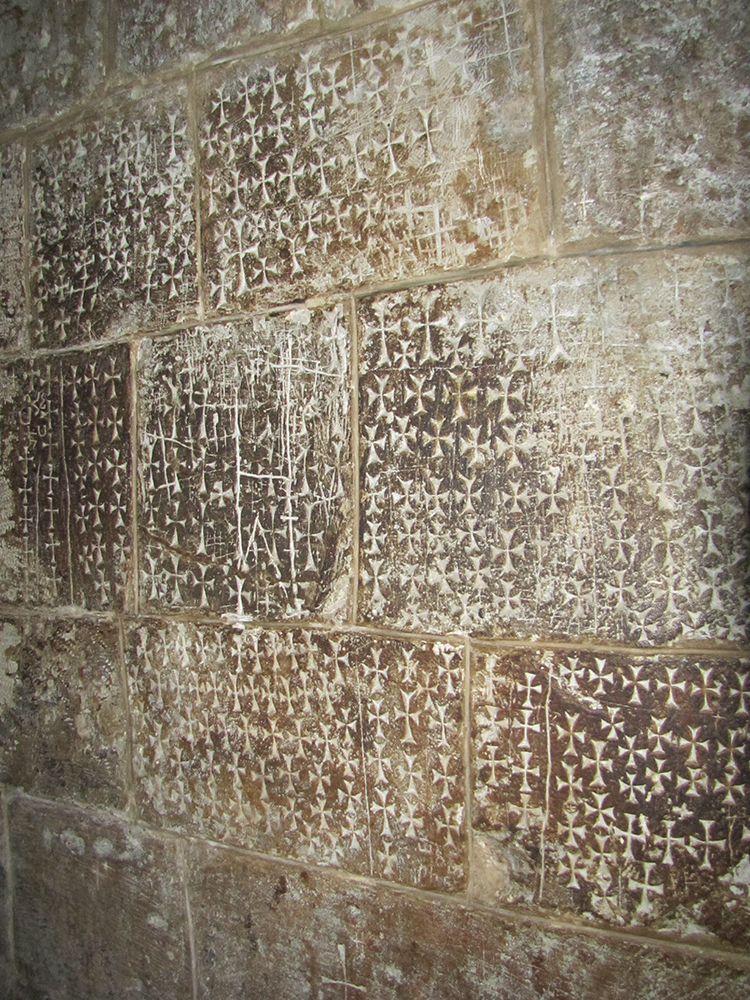
Crosses cut in the walls on both sides of the stairs leading down to the church of St. Helen. This cross graffiti has been carved by pilgrims through the centuries. The design of most of these crosses is from the Crusader period.
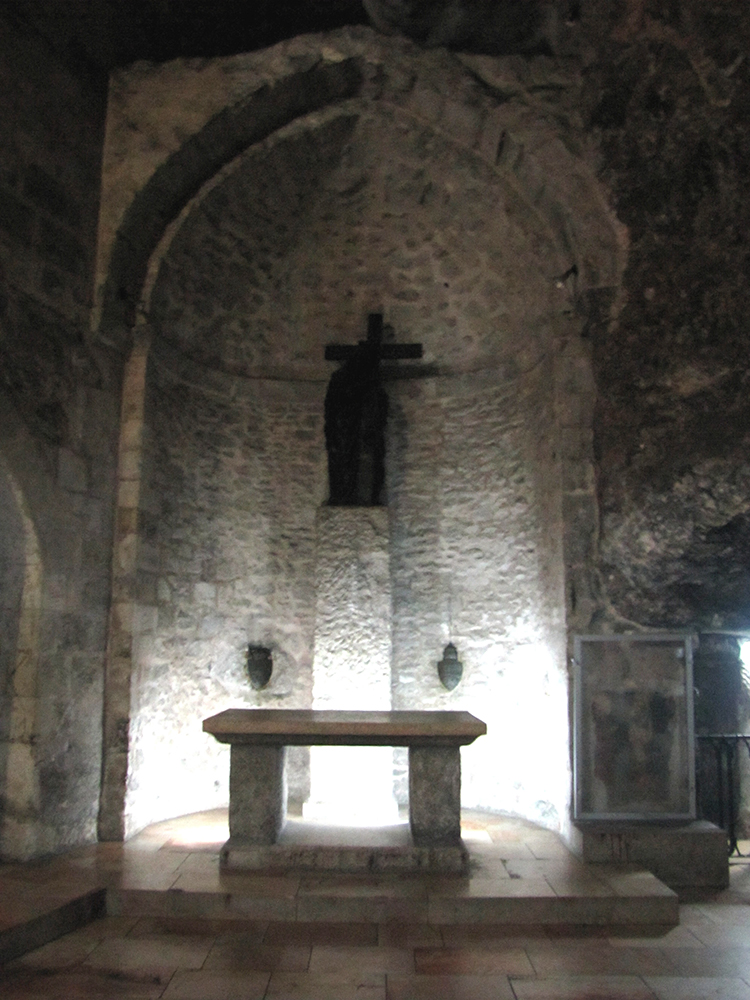
Inside the small opening we can see the original bedrock and tombs in the back. There is a small door to the right that blocks access into one of the tombs.
This is a photo of the Chapel of the True Cross. Tradition says that Constantine's mother found the true cross of Jesus hidden in this chapel when they uncovered the area in 326. A cross that was considered the "true" cross existed, but was taken by the Persians. It was later recovered and restored to the church. Ironically, it eventually disappeared completely due to Christian pilgrims picking pieces of wood from it and taking them home.
The Chapel of the True Cross is the lowest and easternmost point in the Church of the Holy Sepulcher. The chapel got its name from a legend that says Helena found the true cross of Christ there. This “cave” is on the opposite side of other first century tombs and was once a quarry, but after the quarry was abandoned it was converted into a cistern.
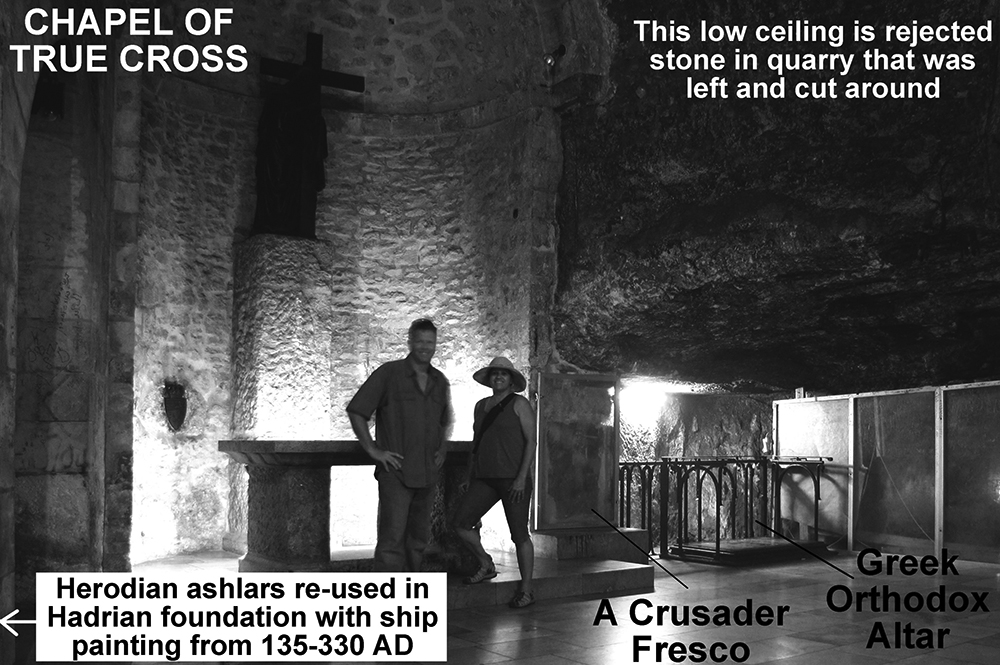
Galyn and Toni in the lowest part of the Church of the Holy Sepulcher, in the Chapel of the True Cross. (When we reached this location we set the camera on automatic-timer and took a photo of ourselves.) The Herodian ashlar with the ship painting is to the left of this photo but is only accessible by returning to the Chapel of St. Helen up the stairs, and then entering the Chapel of St. Vartan from the left side of the altar.
To the right of the altar is a fresco painted by the Crusaders, now protected by plexiglass. To the left of the altar is a small room called the Chapel of St. Vartan. Inside this room are Herodian ashlar stones from the Temple Mount, remains of Hadrian’s foundation walls built in 135 AD for his pagan temples. On one of these ashlars is a painting of a ship with the Latin inscription “DOMINE IVIMUS” (“Lord, we came”) drawn by a Christian pilgrim sometime between 135 and 200 AD. This inscription confirms the belief that early Christians visited this site to honor Jesus, even while a pagan shrine stood here. The boat could be a Byzantine sailing ship with the mast lowered. The bow of the ship is to the left, and the stern and two steering rudders at the back are on the right side. If that is the case, the inscription would be from around the time of Constantine, probably after Constantine had ordered the destruction of Hadrian’s temples but before the Church of the Holy Sepulcher had been built. The inscription is from the traditional Psalm of the pilgrim to Jerusalem:
I rejoiced with those who said to me, ‘Let us go to the house of the Lord.’ Our feet are standing in your gates, O Jerusalem. - Psalm 122:1
Another interpretation of the Latin inscription is “DD M NOMINUS” (“the gift of Marcus Nominus”).
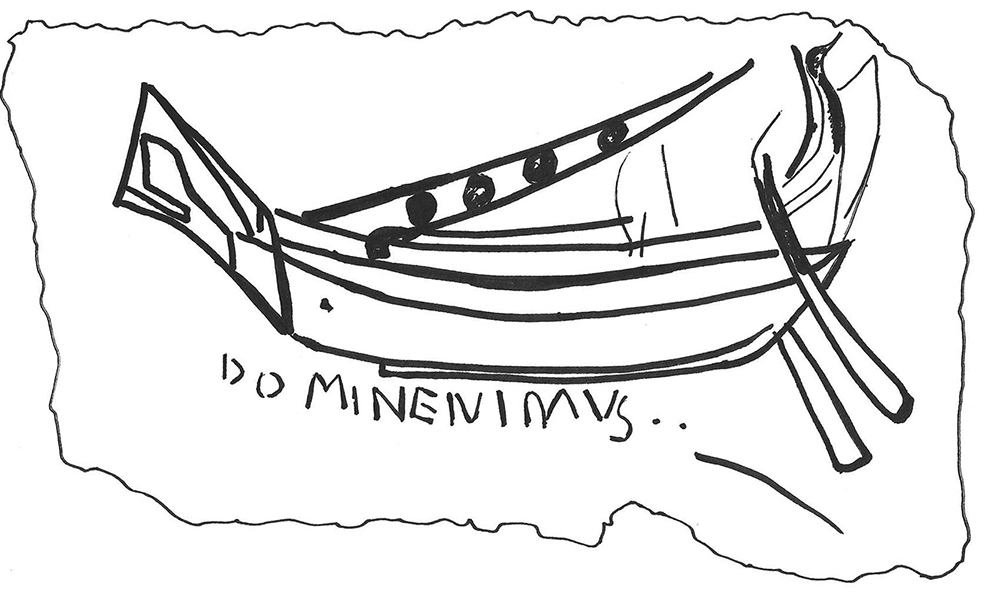
The image of a ship painted on a Herodian ashlar found at the bottom of the Church of the Holy Sepulcher in the Chapel of St. Vartan. It is accessed from the left side of the altar in the Chapel of St. Helen, and is next to the Chapel of the True Cross. Hadrian reused the Herodian stones from the Temple to build his pagan shrine over the tomb of Jesus. It appears a Christian pilgrim visited this site after sailing here from a foreign land. He drew the image of his ship with a lowered sail and wrote, “Lord, we came.”
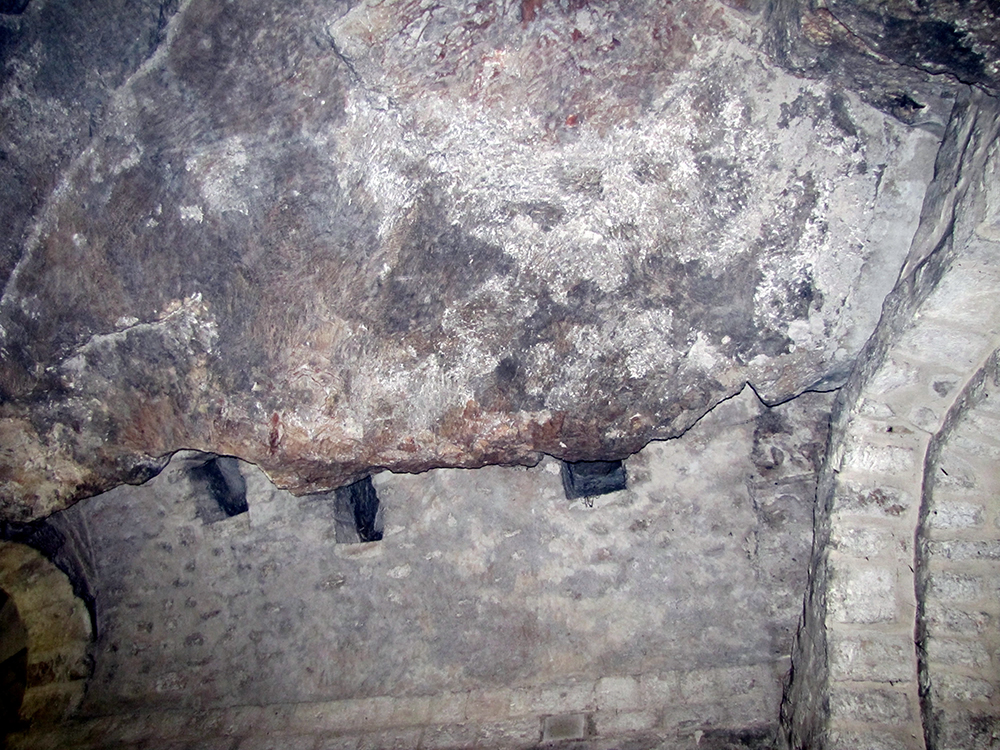
This is the ceiling of the Chapel of the True Cross. The large rock portion at the top of the photo was rejected by the cutters and was left in the quarry. The square openings at the top of the vaulted ceiling were used to lower buckets into this part of the quarry when it had been converted into a cistern before the time of Constantine.
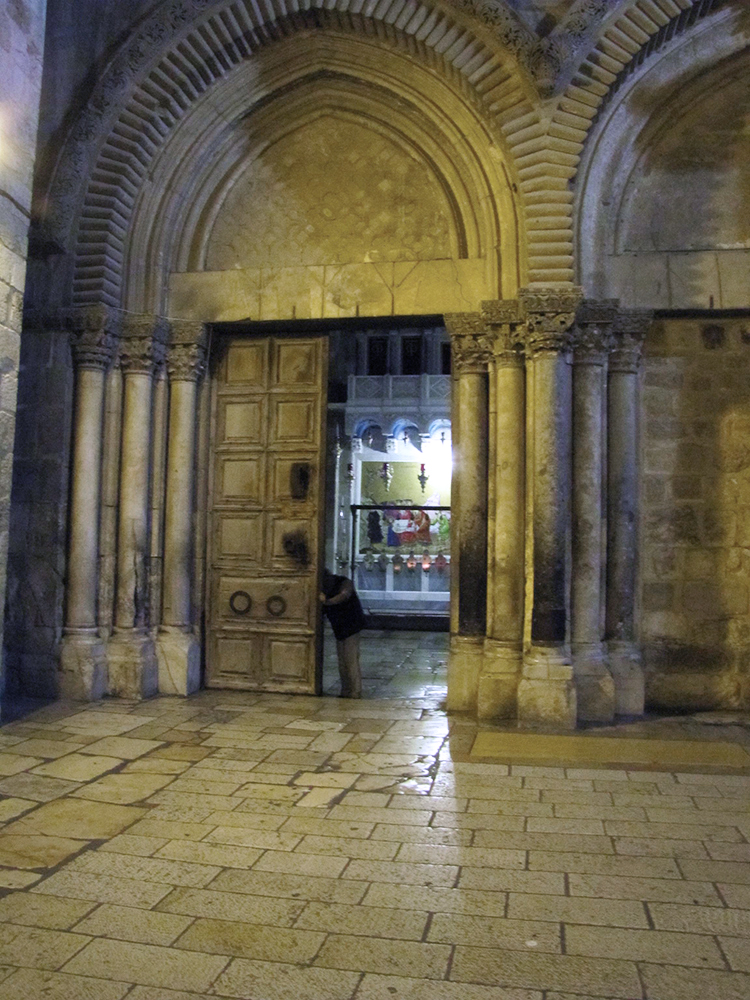
This photo shows the doors of the Church of the Holy Sepulcher being locked by a Muslim man whose family has done it every day since 1178 AD when the Muslim Nuseibeh family was appointed by Saladin to take care of the key and manage the locking and unlocking of the 3 ton doors for the constantly fighting Christian groups. During the 1700’s there were tensions between the Ottoman Empire authorities and the Nuseibeh family, so in 1789 the Joudeh family was given the responsibility of assisting the Nuseibeh family. Since that time a member of the Joudeh family brings the key to a member of the Nuseibeh family who then unlocks and locks the Church door for the Christians.